Your Bicycle Size Guide

Trek Bike Size Chart By Height In CM & Inches (Road Bike/MTB)
A Trek bike size guide is all you need when the search for the correct bicycle size is still on. Known to be the number 1 performance bike brand all over the globe, Trek has been stacked with powerful engineering and classy bikes.
There are many questions revolving around passionate fans of the brand with one of them being, what size Trek bike do I need?
Well, the answer is very simple. You will need to go through the charts below for a particular bike type and model you are looking for.
Trek size charts
Trek bike sizes can vary, and that can lead to more confusion among potential buyers. The below charts will help in choosing the right model according to your height and inseam.
Trek mountain bike size chart
Trek mountain bikes come in different categories and offer sizes for every individual, starting from extra small to extra large. Take a look at the tables below and select the ideal fit for yourself.
Category – Full suspension, Hardtails, Electric, Cross Country, Trail, Enduro, Downhill, Fat Bikes, and Fuel EXe (E-MTB)
Models/Series – Supercaliber, Top Fuel, X-Caliber, Procaliber, Farley, Roscoe, Marlin, Powerfly, Service, 820, Slash, Remedy, Fuel EX, and Session
Trek MTB Cross Country (820)
Trek e-mountain bike.
Models/Series – Powerfly, E-Caliber, and Rail
Trek road bike size chart
Road bikes are an essential part of the brand that caters to a wide range of audience, thanks to its diverse range of models. These Trek road bike size charts shall help you pick the right bicycle that can go a long way for an adventurous ride.
Category – Performance/Gravel
Models/Series – Madone, Emonda, and Domane
Category – Bikepacking/Cyclocross
Model/Series – 520 and 520 Grando
Models/Series – Checkpoint and Boone 6
Model Series – 1120
Trek electric road bike sizing
Models/Series – FX+, DUAL SPORT+, vEREVE+, and Allant+
Trek alpha sizing for MTB – what is it?
The old-school approach of measuring the frame size of Trek bikes is a thing of the past. With newer inventions and modern bike geometry, alpha sizing is used in place of numeric sizing on Trek mountain bikes.
Why is alpha sizing important?
1. Easier approach
Instead of using size numbers like 19.5, the sizes can be classified into S, M, ML, L, XL, and XXL. So, someone with a 17.5 size can go for the medium and a 19.5 is a large size. You don’t have to keep a tab on numbers; instead, the alphabet makes it easier.
2. Measurement based on reach
In earlier times the frame size measurement of Trek bikes was solely based on seat tube length. Things have changed, and modern mountain bike geometry focuses more on reach as of now. Hence, alpha sizing measures what matters and is a more simplified way of measuring bike size.
Trek sizing – virtual vs actual
This can puzzle you a bit as they both are somewhat similar yet there is a subtle difference. Actual size can be termed as the overall length of the seat tube from the center of the bottom bracket to the center of the top tube intersection with the centerline of the seat tube.
On the other hand, virtual sizing is the overall length of the seat tube ranging from the center of the bottom bracket to the mid-point of the imaginary horizontal top tube in which it connects with the seat tube.
If I had to give you an example, a bike might have a virtual size of 18.5 and an actual size of 17.5. This means that the bike size feels like 18.5, but in actual sense, the frame size is 17.5. It doesn’t make much of a difference as it is there only to let you know what it is (actual size) and what it looks like in size (virtual size).
People also ask
Trek 17.5 frame size – what does it mean.
A 17.5 frame size is considered an M size (Medium) in terms of alpha sizing. Any individual who is 161-172 cm or a height of 5’3.4”-5’7.7” . If you are within this height range, going for a medium size shall be the right choice.
Trek medium frame size is for what height?
A medium size frame size (17.5) is ideal for a person with a height between 5’3.4”-5’7.7 ”. In centimeters, it is ideal for those around 161 to 172 cm in height.
Trek 24-inch bike is for what age?
When it comes to children, their bikes are measured in terms of wheel size instead of the standard frame size. These kid’s bikes have a size range between 12-26 inches, depending upon the height of the kid.
As far as a 24-inch wheel size is concerned, any kid between the ages of 8-11 can go for a fun ride with it. Some of the popular 24-inch bike models are Trek Roscoe 25, Wahoo 24, Trek Precaliber 24 , etc.
Trek 26-inch bike is for what height?
A 26-inch wheel-size bike is for kids with a height of 4’9”-5’3” (146-160 cm) . Wahoo 26 is a prime example of a bike in this category.
Trek 20-inch bike is for what age?
Trek 20-inch bikes are for children between 5 to 8 years of age. Additionally, if they are within the height of 3’9”-4’6” , it should be suitable for them.
Are Trek bikes good?
Trek bikes are considered to be extremely good and solid in build. It is known to be the number 1 performance bike brand all over the globe. Having its humble beginning in the year 1976 in Waterloo, Wisconsin, it has turned into the largest bicycle manufacturer all over the world. With an array of bikes ranging from, mountain, road, electric, and kids bikes, there is a lot to choose from a mammoth list.
How much is a used Trek bike worth?
It depends on a lot of factors in terms of how old the bike is, the year of production, which model, and a lot more. However, it can be within $1000-10,000 (depending on the model and other factors) .
Where are Trek bikes made?
The majority of their bikes are manufactured in Taiwan, China, Netherlands, and Germany too.
Why are Trek bikes so expensive?
Usually, the bike brand prefers top-tier components, suspensions, and frames that are ahead of its competitors. This results in additional costs that can be seen in the price tag and also many top-end Trek bikes are custom-made with less production, leading to being more expensive.
Trek bikes are a class apart in many ways with a range of bikes on offer for its fans across the world. Choosing the right size for you can be tricky, but this is where the Trek frame size chart comes to the rescue.
Trek as a bicycle brand might be on the costly side, but they punch above its weight to provide top-class bikes for the masses. I am always someone who roots for quality, and Trek provides what I need.
One comment
Thanks for your informative post. I really like the Trek alpha sizing for MTB because Trek frame sizes use alpha sizing rather than the usual inches or centimeters (cm), and they usually have a certain range of measurements.
Leave a Reply Cancel reply
Your email address will not be published. Required fields are marked *
Save my name, email, and website in this browser for the next time I comment.
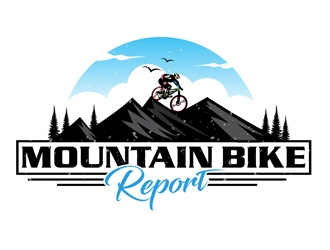
- Recommended Gear
- Beginner Info
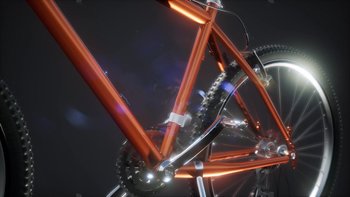
Mountain Bike Sizing and Fitting (Ultimate Guide)
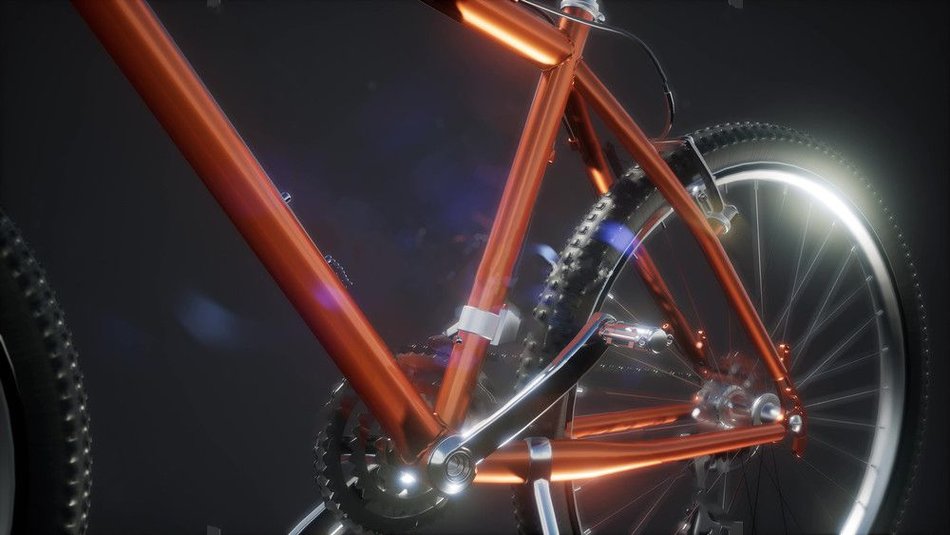
No matter which mountain bike you choose it has to match your bodies measurements as closely as possible. This mountain bike sizing and fitting guide will help you do just that.
If you get this wrong and start riding a bike that does not fit you then you will not be able to reach your full potential as a rider. Having the wrong size bike for your body will not only be uncomfortable but your riding performance will be lower.
Size and Fit For an Assembled Mountain Bike
Stand-over height.
- All mountain bikes have a top tube, but not all top tubes are designed exactly the same way. It is important that there is enough stand-over height so that if you need to jump off your bike you will not hit your crotch and injure yourself.
- The best way to determine stand-over height is to stand flat foot over your bike’s top tube. From this position lift up the bike straight up until the top tube touches your crotch.
- Then make sure that the wheels are at least 2 inches off the ground. Two inches would be the minimum. But if you jump off you will probably bend your knees. So a stand-over height of up to 5 inches or more is good as well. There is no maximum limit.
- It is a good idea to also ride the mountain bike slowly and then jump off to a standing position as you straddle the top tube. Make sure to bend your knees as you land. Do this a few times and bend your knees more or less each time so you get a good feel for how much room you have above the top tube.
- You will need to do this for every bike you are interested in. This is because one bike from a particular manufacturer with a listed frame size of medium will have a different stand-over height when compared to another bike manufacturer with a listed frame size of medium.
- This happens because manufacturers usually measure frame size in different ways. Also different manufacturers have various ways of designing the top tube of their mountain bikes. Some have a slope or are curved differently. They also use different bottom bracket heights. All of these variables will cause a different stand over height for each bike.
- All manufacturers measure the frame size from the center of the bottom bracket up to the top of the seat tube. But the measurement changes at the top end of the location.
- Some measure to the top of the seat tube, some measure to the top of the top tube, and some measure to the center of the top tube. You can see now that each of these methods will give you a different frame size for the same frame.
- The stand-over height of a particular mountain bike is determined by the slope and design of the top tube and the bottom bracket height, no matter how the frame size is measured.
- Because of this, where you stand over the top tube is very important. Most top tubes slant up from the seat post to the headset. It is a good idea to straddle the top tube 1 or 2 inches ahead of the nose of the seat if the top tube has an upward slant.
- You also have to consider the different levels of travel that mountain bikes have. A bike with suspension fork travel of 80mm or 100mm will have a lower front end than a bike with a 125mm travel suspension fork. Even a bike with a rigid fork will be lower because the frame has to accommodate the rising and falling of the front wheel.
- On a full suspension bike the pedals need to be higher off the ground to make sure that the pedals and bottom bracket clear obstacles when compression of the suspension occurs. This makes a full suspension bike the tallest type of bike by design.
- Finally, different wheel sizes will play a part in determining the stand over height. A 29er bike will have a higher front end than a bike with 26 inch wheels even though they have the same fork travel. This makes it hard to determine stand-over height even from the same manufacturer when you are comparing listed frame sizes.
- If you are looking at one bike manufacturer and two frames which are listed as large but the wheel size and or the top tube design is different then the stand-over height will be different.
- The only way to be sure is to actually go and stand over the bike yourself. If you have stood over a few different bikes and the stand-over height is not at least 2 inches, then try standing over bikes with a smaller wheel size.
Do Your Knees Clear the Handlebars
Even when you are in the most awkward pedaling position, check that your knees will not hit the handlebars. The best way to check this is while you are seated in the saddle.
You should turn the front wheel slightly to the left and to the right and check your knees. Also be sure the balls of your feet are on the pedals and not your heels.
Handlebar Reach and Comfort
- As you ride the bike notice how you are holding the handlebars and bar ends. Does it feel comfortable, can you reach them easily, while maintaining a slight bend in your elbows.
- Make sure while holding the handlebars that your knees do not hit your elbows as you pedal. You should also be able to grab the brake levers easily. Check that you can lower and raise the stem so that you can set it to a level that is comfortable for you.
- Stem height can be adjusted but only up to a certain limit. If it can not be adjusted so that it is comfortable then you may want to replace the stem with another one. Another option is if the stem is too short because you are tall then try a bike with larger wheels.
- A bike with 29 inch wheels will have a longer fork and higher handlebars than a bike with 27.5 wheels or a bike with 26 inch wheels. Mountain bikes with larger wheels have longer forks, which therefore will give you higher handlebars. If you are shorter then go down in wheel size.
Toe Overlap
Toe overlap is the situation when you are riding slowly and you make a sharp turn and your toe hits the front tire. This can be avoided by doing a toe overlap check. Begin by sitting on the bike and pedal the crankarms until they are horizontal. Now turn the handlebars and see if your toe hits the front tire or not.
Making sure there is no toe overlap is especially important when riding slowly, such as during technical riding. When pedaling up rough terrain slowly the front wheel can turn quickly back and forth as your toes pass by while pedaling.
When you are riding at faster speeds toe overlap is not a problem because the front wheel can not be turned right or left enough at an angle to be at risk of hitting the foot. If you turned the front wheel sharply while going fast you would probably crash.
Use Body Measurements to Determine Frame Size
In order to figure out which frame is right for you, you will need to take 3 measurements. These measurements are your inseam, your inseam plus torso length, and your arm length.
Inseam Length
Stand barefoot with your feet about 3 inches apart and firmly hold one end of a tape measure up into your crotch on the right or left side. Then have another person bring the tape measure straight down to the floor.
You can also firmly pull a book up into your crotch so it is pushing on the pelvic bone. Then mark the top level of the book onto a wall. Finally, measure from the floor up to the mark on the wall.
Inseam Plus Torso Length
While standing up straight place the eraser end of a pencil horizontally against the u-shaped bone indentation just under your Adam’s apple. Then face a wall and mark the wall with the horizontal pencil. Now measure from the floor up to the mark.
With your elbow straight, raise your arm out away from your body at a 45 degree angle pointing downward. Have someone help you if you are using a tape measure. Measure from the wrist bone on your little finger side up to the sharp bone point, which is directly behind and above your joint.
Find Your Frame Size
- Now that you have your measurements subtract 36 to 42cm or 13.5 to 16.5 inches from your inseam length. This length represents measuring from the top of a horizontal top tube to the center of the bottom bracket. If you want an estimated center to center size, subtract 3/4th of an inch.
- You should subtract closer to 36cm if you are a shorter rider. Subtract closer to 42cm if you are a taller rider. Remember full-suspension bikes usually have higher bottom brackets which lower the stand-over height. So the more suspension travel your bike has the shorter the seat tube length you will want.
- Never subtract less than 36cm from your inseam to get your seat tube length because you want to make sure you have at least 2 inches of stand-over clearance.
- On the other hand look for a bike with 27.5 inch wheels or 29 inch wheels if you are a taller rider. You could also use a very long seat post which would seat you further back out over the rear wheel.
- For females who have a step through bike which means it has a very long slanted top-tube upward beginning near the bottom bracket. This type of top tube makes stand over clearance a non issue.
Top Tube Length
To find your top tube length you need to know your torso length. Begin by subtracting your inseam which you found before from your inseam plus torso measurement, also found before. Now add the torso length to the arm length.
Finally, multiply the arm plus torso length by 0.47 if you are a casual rider. If you are more of an aggressive rider use 0.5. If you are in between casual and aggressive use 0.48 or 0.49.
The top tube length on a bike is measured horizontally from the center of the head tube to the center of the seat tube. This line is an imaginary line, it does not measure anything physical.
Don’t measure along a sloping top tube because your body position will not follow this measurement. Your body position goes horizontally from your butt seated on the saddle going forward with your hands reaching the handlebars.
Stem Length
If you are a casual rider multiply the arm plus torso length by 0.085. If you are a more aggressive rider then multiply closer to 0.115. If you are in between casual and aggressive then multiply somewhere in the middle. Use this as a guide. The only way to be certain is to actually sit on the bike.
Crankarm Length
In general tall riders should use a crankarm length of 180mm or longer. Shorter riders should use a crankarm length of 170mm or shorter. Usually mountain bikes are designed with a crankarm length somewhere in the middle, normally 175mm measured hole to hole.
Position of Saddle and Handlebar
We are going to determine the correct position for the saddle height, saddle setback, handlebar height, and handlebar reach. If your saddle and handlebars are not set properly then it does not matter how good of a frame size you have chosen. You will be uncomfortable and your performance will be reduced.
Saddle Height
- There are two easy ways to determine the proper saddle height. The first is to sit on your bike while it is mounted on a stationary trainer stand or you can have someone hold you up and keep the bike straight.
- Now pedal forwards until one of your feet is at the bottom of the pedal stroke. Be sure to lock out your knee and put your heel on the pedal, not the ball of your foot.
- The reason for this is when you do put the ball of your foot on the pedal at the bottom of the pedal stroke your knee will be slightly bent, as it should be. The next way to get the right seat height is by using your inseam measurement.
- Take 1.09 and multiply this number by your inseam measurement. The number 1.09 is the length from the top of the saddle where it makes contact to your sit bones also called your ischial tuberosities, to the center of the pedal spindle at the bottom of the pedal stroke. Once the calculation is made and you have the result, adjust the seat height so it matches the resulting number you got.
- Both of the above methods will give you similar results and they are for matching your body size to your bike. But if you are more of a technical rider you should get a dropper post. For this type of riding you will want better bike handling so a lower saddle is better for this.
Saddle Setback
Saddle setback has to do with how far forward or backward the seat is set. When this happens it will move your knees more forward or backward when you pedal which changes where the pedal power is focused.
Begin by putting your mountain bike on to a stationary trainer. Then sit on your bike and pedal the crankarms until they are horizontal. Make sure your feet are at their normal position on the pedals.
From a point just below your kneecap on the front of your knee have a person drop a plumb line. You can try using a washer or a heavy ring tied to a string for the plumb line.
The bottom end of the plumb line should make contact with the end of the crankarm. This approximates the center of rotation of the knee over the center of rotation of the pedal.
Following the plumb line down from a point just below your kneecap, your kneecap should be lined up, up to 2cm behind the end of the crankarm.
A saddle positioned at this location promotes smooth pedaling at a fast pedal stroke per minute. If the knee position is set up 2cm farther back this will promote powerful seated climbing uphill.
If the saddle position is pushed farther forward this will help to keep the front wheel on the ground while on steeper climbs. The best foot position is to make sure the ball of your foot is right over the pedal spindle or up to 2cm ahead of the pedal spindle.
If you have larger feet, position your cleats further back, as far back as possible while keeping the ball of your foot over the pedal spindle. Same thing if you have short feet but in reverse. Position your cleats further forward.
Handlebar Height
- In order to determine the handlebar height you need to measure the handlebar height from the ground up to your handlebars. Then determine the saddle height by measuring the vertical distance from the ground up to the saddle.
- Once you have both numbers subtract one from the other. How much higher or lower you set the saddle compared to the handlebars depends on your body’s flexibility, your riding style, overall size and the type of riding you prefer.
- You can start by setting your saddle 10cm higher than your handlebars if you are a taller rider. Short riders will want to set their saddle lower when compared to their handlebars.
- Raise your handlebars higher if you do lots of downhill riding or slalom riding. Beginner mountain bikers should start with handlebars and then lower them later as they become more experienced and comfortable on their bike. To start you can have the saddle 4cm lower than the handlebars, and make adjustments from there.
- Remember, the front wheel will have a greater chance of pulling up off the ground when climbing if the handlebars are higher. Higher handlebars also mean more wind resistance at times, but you will have more comfort and control riding down on technical terrain with drop offs.
Handlebar Reach
An easy way to begin determining handlebar reach is to use a plumb line. Put your mountain bike in a stationary trainer. Then sit on your saddle and grab your handlebars as you would when riding. Pedal forward so the crankarms are horizontal.
You should be in a comfortable riding position. Have a friend drop a plumb line from the back of your elbow with your arms bent. The plumb line should go down past your knees. The plumb line should be 2 to 4cm ahead of your front knee.
Generally, more aggressive riders will want a more out stretched position than more casual type riders. The correct handlebar reach is more dependent on person preference, but the elbow plumb line measurement is a good starting point. It is up to you from there to experiment a little and see what works best for you.
Bar End Position
- Bar ends are not as popular on bike today but they are beneficial for those riders that choose to use them. They are usually found on cross country bike. Bar ends can be used by both performance riders as well as casual riders.
- Performance riders use bar ends in order to increase their pulling power when they are climbing uphill out of the saddle. The most effective position for the bar end is at a 15 degree angle up from horizontal.
- This angle increases pulling power because the bar ends are perpendicular to the forearms when you are standing on the pedals while pedaling. It also makes for a lower, more extended position when you are seated. This is more aerodynamic and reduces wind resistance.
- The bar end angle for casual riders should be 45 degrees. This allows riders to pull with a straight wrist and a closed fist while remaining seated. You can begin with a 45 degree position, keep the nuts loose, then adjust the angle to your liking and tighten the nuts.
Inner Bar End Position
Inner bar ends are more commonly used than outer bar ends. They should be placed more inward than the grips. They are more effective when placed on wide riser bars, as opposed to standard handlebars.
You will find that your shoulders are supported more, and your arms are in a more relaxed comfortable position when using inner bar ends. The correct position of the inner bar ends is up to you and your personal preference. Determine what is most comfortable and effective by experimenting with various angles.
You can place your hands on the brakes while riding on the inner bar ends. Inner bar ends are most effective on non technical terrain. The narrow position of it allows for enhanced comfort, as well as efficient aerodynamic riding.
Mountain Bike Sizing Chart and Guide
Your Height Inseam Length Frame Size 4’11” – 5’3″ 25″ – 27″ 13 – 15″ 5’3″ – 5’7″ 27″ – 29″ 15 to 17″ 5’7″ – 5’11” 29″ – 31″ 17 to 19″ 5’11” – 6’2″ 31″ – 33″ 19 to 21″ 6’2″ – 6’4″ 33″ – 35″ 21 to 23″ 6’4″ and up 35″ and up
Stand Over Heights From Manufacturers
Cannondale Trail Bike
Extra small frame, wheels 27.5, standover 71.0cm Small frame, wheels 27.5 standover 74.6cm Medium frame, wheels 27.5, standover 77.4cm Large frame, wheels 29 inches, standover 82.0cm Extra large frame, wheels 29 inches, standover 85.0cm Extra extra large frame, wheels 29 inches, standover 88.0cm
Trek Marlin 2019
13.5 inch frame size number, wheels 27.5, standover 70.5cm 15.5 inch frame size number, wheels 27.5, standover 72.8cm 17.5 inch frame size number, wheels 29, standover 74.3cm 19.5 inch frame size number, wheels 29, standover 74.7cm 21.5 inch frame size number, wheels 29, standover 75.0cm 23.0 inch frame size number, wheels 29, standover 78.3cm
Whenever you find the stand over height for a mountain bike listed by the manufacturer make sure that your inseam is at least 2 to 4 inches or 5.08 to 10.16cm above the stand over height listed. This is a good starting point for determining which size bike you should consider first.

Mountain Bike Frame Size Chart: 3 Easy Ways to Get the Perfect Fit
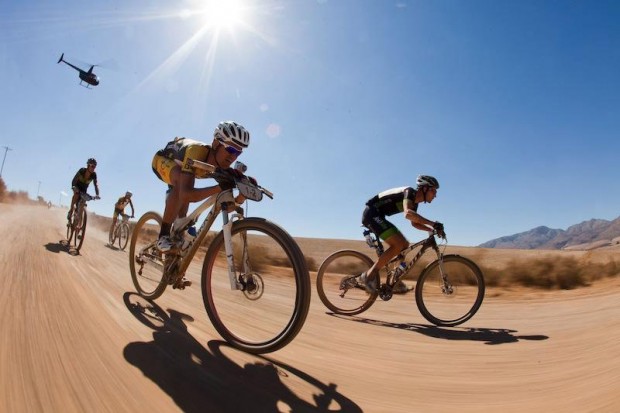
What size mountain bike frame do I need? That’s one of the most commonly asked questions by our readers.
Ordering bikes online is becoming more and more popular. Bikes are typically more affordable online than in local bike shops because overhead costs are lower, allowing online stores to sell their bikes at cheaper prices.
But what about the good old rule that says you need to try a bike before buying it? While this can be beneficial, it’s often an overrated method and not necessary for everyone.
If you go to a local bike shop and sit on a bike, you’re more likely to buy it, which is why shopkeepers would like you to do it. But the reality is that most novice riders don’t know how a bike should feel during their first test ride, so this sizing method is not valuable for inexperienced riders.
You should try your bike first! Not completely true!
Even though everyone is built differently, most people’s bodies fall into certain categories in terms of height, inseam length, and arm length. Therefore, unless you’re have an unusual ratio of upper and lower body length, you can trust mountain bike size charts to recommend you the right frame size.
Related : Best Mountain Bikes You Can Get
With that in mind, there are several reliable methods to choose the right mountain bike frame size.
In this article, I’m going to show you how to use mountain bike size charts and online calculators to get the right size and fit in seconds!
Method #1: Mountain Bike Size Chart
Method #2: online bike size calculator, method #3: mountain bike sizing formula, bonus tip: finding the right saddle height, mtb geometry guide, how to choose when in-between two sizes, what if i still got the wrong bike size.
The easiest way to find the correct bike size is by using a mountain bike frame size chart. This is a simple method that lets you compare your height and/or inseam length against a chart that recommends the correct frame size.
Mountain bike frame sizes are measured based on seat tube length , expressed in inches, which typically ranges from 13″ to 24″. Effective top tube length (the horizontal distance between the head tube and the seat tube) plays a role as well, but seat tube length is a more common measurement.
Some manufacturers also use size classes, such as XS, S, M, L, and XL, but these are not as reliable as using inches because the measurements can differ from one brand to another.
What mountain bike frame size do I need? Find the answer in the chart below:
Bonus tip: If you’re buying a bike on Amazon, you can also check out their Amazon Fit Guide which includes sizing recommendations for adult road bikes, adult mountain bikes, and kids’ bikes.
Related: Best Gravel Bikes You Can Buy
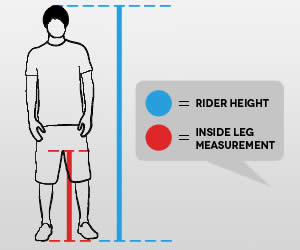
These are interactive tools that let you enter your height and inseam length and then recommend you the correct size or range of sizes to consider.
Before you can use one, you need to learn how to correctly measure your inseam. Here’s a quick step-by-step guide:
- Take off your shoes and stand with your legs 6″ to 8″ (15-20 cm) apart.
- Place a book between your legs, as far up as you can.
- Measure the length from the ground up to the top of the book.
- Voila! This is your inseam length that you can now enter into an online bike size calculator.
When using a bike size calculator, make sure to choose the right type of bike—mountain bike, city bike, or road bike—as the measurements will differ based on that.
If you’re not sure about it, you can read more about the different bike types here .
Here are the top online bike frame size calculators we recommend:
1. Ebicycles.com Online Calculator : An easy way to find the right MTB frame size by using your height and inseam length. 2. Competitive Cyclist Fit Calculator : A more detailed bike fit calculator that lets you know the correct standover height range, top tube length, saddle height, and more. 3. Jenson USA Bike Fit Calculator : Another in-depth bike fit calculator that suggests the right bike size and helps you nail the fit afterward.
One of the easiest but also the least reliable methods of finding the right mountain bike size is using a simple mathematical formula that uses your inseam length.
It goes like this:
Leg inseam (cm) x 0.66 = Your frame size
For example, if your leg inseam is 76cm , multiplied by 0.66 then your correct mountain bike size is 20″ (50cm) .
This method is only good for approximating the correct size, but we don’t recommend relying on it exclusively. It’s best to combine it with the results you get from the mountain bike size chart and online calculator that we’ve shown you above.
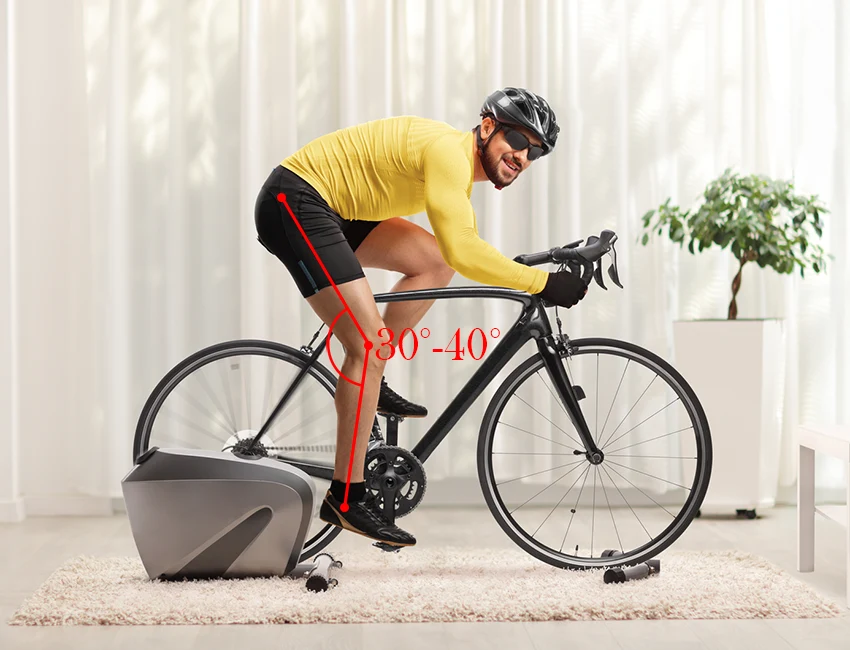
Setting the saddle height correctly has a very important impact on the overall bike fit.
If the saddle height is too low, you won’t be able to transfer power to the pedals effectively and your legs may fatigue more quickly. I have experienced that firsthand in mountain bike racing—when the saddle falls down by one inch from its ideal position, I lose about 25-50% of my power .
Now that we know how important finding the perfect saddle height is, how should we do it?
The easiest way is to:
- Hop on your bike wearing the shoes that you typically use for cycling (flat or clipless).
- Lean against the wall for support or have someone help you stay in an upright position. You can also use a bike trainer for this purpose.
- Push the pedal down to its lowest point (6 o’clock) while keeping the foot parallel to the ground.
- At this point, you should have a slight bend in the knee, as shown in the image above. Adjust the saddle height accordingly until you achieve it.
The next step is to go outside and ride . Does it feel good? If not, then make further minimal adjustments (a few millimeters at a time) until the saddle height feels natural, your power transfer is optimal, and you’re not feeling any pains or aches.
Related: Check Out The Best Fat Tire Bikes

Once you’ve determined your ideal saddle height, it’s a good idea to mark that position with a marker, as saddles can lower with time. Some bikes come with height indicators on the seat post, so make sure to remember the correct marking for future reference.
Mountain bike geometry refers to the actual shape of the bicycle, the measurements of different tubes and angles, and their relations to each other.
Here’s a brief guide on the most important measurements you need to be aware of to get the right fit:
- Reach: This measurement refers to the horizontal distance between the center of the bottom bracket to the top center of the head tube. It affects the length of the bike and the overall stability and ride feel.
- Stack: Refers to the vertical distance between the center of the bottom bracket to the top center of the head tube. It affects how upright your position will be and how tall the handlebar will be.
- Standover height: This is the height from the ground to the top of the top tube. Make sure that this measurement is at least an inch shorter than your inseam length to be able to stand over the bike with both feet flat on the ground.
- Wheelbase: This is the distance between the centers of both wheels. A shorter wheelbase provides more agility, while a longer wheelbase improves stability.
- Head tube angle: This is the angle between the ground and the bike’s fork. A slacker angle (lower number) means the bike is more stable on rough terrain, while a steeper angle allows more responsive steering.
- Seat tube angle: This measurement refers to the angle between the ground and the seat tube. A steeper angle improves climbing ability, whereas a slacker angle is better for descending.
So you’ve consulted a mountain bike size chart or an online calculator and the results put you right in the middle of two sizes. What do you do? Should you size up or size down?
Each option has some pros and cons and the final decision depends on your:
- Flexibility
- Leg-to-torso length ratio
- Riding style
Here are some of the most important factors to consider when deciding whether to get a one size bigger or smaller mountain bike.
When to Size Up?
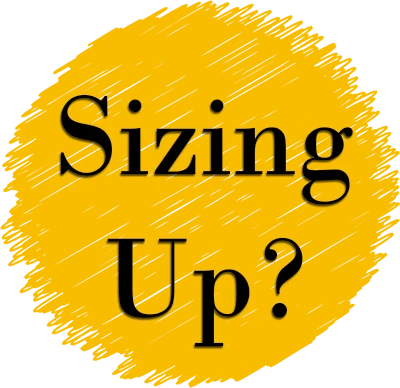
Mountain bikes grow in length (reach) and in height (stack) with each frame size. But modern mountain bikes grow more in length (reach), which is why this is a more important measurement to consider.
Assume you are in between two sizes and you decide to size up. You’ll get a bike with a longer top tube and a longer wheelbase, which means your handlebar will be further away from the saddle.
How does this affect the factors we’ve mentioned above?
Flexibility: This is a good option for riders who are flexible and can easily reach their toes when bent over. A longer top tube means you will need to hinge more at the hips, which can be painful and uncomfortable if you’re stiff and have a short range of motion.
Leg-to-torso length ratio: If you have short legs and a long torso, you should size up when buying a mountain bike as this will give you a more neutral fit. But make sure that the standover height is not too high so that you can’t stand over the bike comfortably.
Riding style: Finally, a larger frame size translates to a longer wheelbase, which means the bike will be more stable on rough terrain and go over obstacles with more ease, but it will feel less playful and more difficult to maneuver.
When to Size Down?
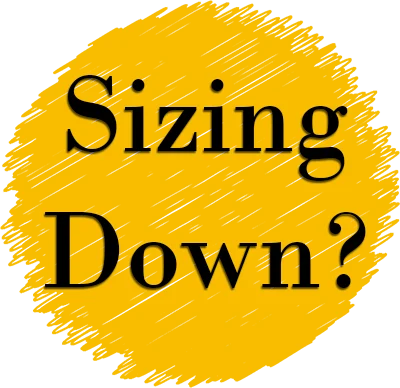
Similarly, a smaller mountain bike will have a significantly shorter reach and a slightly shorter stack and wheelbase. A smaller bike will also have a shorter maximum seat post height, so you may need to extend it depending on how long your legs are.
So how does this relate to the three most important factors mentioned above?
Flexibility: If you are not a flexible person and you struggle to reach your toes with your fingers, then you’ll benefit from a shorter reach a smaller mountain bike frame size offers. It will put you in a more upright riding position, with handlebars closer to your body, which means you can ride for longer without experiencing discomfort.
Leg-to-torso length ratio: Sizing down is a logical choice for riders who have longer legs and shorter torsos. This way, the bike will feel more comfortable, but you may need to use a longer seat post to get the proper leg extension.
Riding style: A smaller mountain bike with a shorter wheelbase will feel more nimble, playful, and easier to handle over rough terrain. If you like flicking your rear wheel and going around obstacles instead of plowing through them, a smaller bike is the right choice.
Sometimes, even after going through all the methods and consulting several mountain bike size charts, you may find that the bike doesn’t feel right and that you’ve probably chosen the wrong bike size.
Don’t worry, if you’re off by one size or even half a size, there are easy fixes you can try to improve the comfort and fit!
The first thing to do is to contact the retailer/manufacturer and try to get a replacement. Under the right conditions, you’ll be able to get a different frame size bike without significant additional costs.
If you don’t want to go through the hassle of shipping the bike or this option is not available, you can try the following things:
- Adjust the fore-aft position of the saddle: The fore-aft position of the saddle can be adjusted slightly to lengthen or shorten the reach. Make sure not to overdo it so your knee doesn’t end up too far in front or behind the middle of your foot when in the 3 o’clock position.
- Replace the stem: By using a longer or a shorter stem, you’ll be able to increase or shorten the reach by a few centimeters. In most cases, this will be enough to significantly improve the feel and ride quality.
- Replace the seat post: If you bought a bike that is too small and you can’t extend the leg fully when pedaling, consider using a longer seat post.
- Replace the handlebar: A shorter handlebar will be easier to reach and will put you in a less stretched-out position and vice-versa. If you’re using drop bars, consider getting a model with a shorter or longer reach to fine-tune your fitment.
- Raise the handlebar: You can easily achieve a more upright riding position and increase the stack measurement by raising the handlebar with headset spacers. If there are headset spacers above your stem, simply move them underneath to move the stem and handlebar higher up.
- Get a professional bike fitting: A professional bike fitter can do all of these steps for you, which is the best option you have, but also the costliest.
Most importantly, give yourself time to get accustomed to your new bike. Sometimes, your body needs a few days or weeks to adjust to the new riding position.
I remember when I got my first 29er mountain bike. It felt huge and I found it difficult to ride it on narrow winding trails and on technical terrain. However, now that I’m used to the 29er, the 26″ mountain bike seems almost comically small.
Mountain Bike Reviews
Are you in the market for a new mountain bike? Start with one of our mountain bike buying guides below:
- NEW! Best Electric Mountain Bikes
- Best Cheap Mountain Bikes
- Top 11 Best Full Suspension Mountain Bikes
- Best Mountain Bikes Under $500
- Best Mountain Bikes Under $1,000
- Best Mountain Bikes Under $2,000
- Best Mountain Bikes You Can Buy on the Market
Related Topics:
299 thoughts on “ mountain bike frame size chart: 3 easy ways to get the perfect fit ”.
Hi I’m 5’11 with 32″ legs and slighter shorter wing span to height. Am looking at getting the giant xtc slr 29. Do you recommend M or L? Thanks.
Hi Ian, considering all your measurements, I think you won’t go wrong if you choose the smaller M frame size.
You should also consider your riding style, as the size of the frame will affect how the bike feels. For example, if you prefer a more nimble, responsive ride and you value quick handling for tight trails, go with Medium. However, if you want a more comfortable, stretched-out position and you prioritize stability at higher speeds, you should go with Large.
But if you’re simply worried about getting a comfortable fit, I say you should choose Medium.
Hi. I am 6ft 1 90kg. Should I go for XL or L?
Hey TJ, I think a 19″-20″ (L) mountain bike would be the right choice for you.
I am wanting a bike with the 29” wheel. I am that 5’11 to 6’1 I want to spend 1000 for a hard tail. My inseam is short like 31” I do like the Cannandal the black one. I just want a good rider. Do I want the 27” wheel? I think the large frame not sure at all
Hey Richard, at that height, both a 29er and a 27.5er will fit you fine. Size Large Cannondale should be the right choice for you considering your 5’11” to 6’1″ height.
Hello, I am 165cm in height.. so can i ride on a 17-inch frame bike? Is it suitable for my height?
Hey Am, you should be better off with a 15″-16″ bike, but depending on the model, a 17″ bike could fit you as well. It’s best to give it a try if you can.
I’m 5.7 – right in the middle of a MED and a SM… so hard to decide what size I should go with.. is it really much of a difference? I’m looking into a Fusion 30 2022… I ride both pathways/roads to basic mountain trails… Is the only difference the more responsiveness in a small rather a med?
Hey Christa, it’s usually better to go for the smaller size when you’re right in the middle. It’s a lot easier to lengthen a smaller size bike than shorten a larger size. So I would say go for a SM and enjoy it.
Great article!! It definitely clears out some of my struggle. But still, I have this main concern that is the right range of reach and stack for my height. I am 5″11, 180 cm. I have longer limbs than most people, but super lean, about 68 kg 150 lbs. I am currently riding a L hardtail with 470 reach and 620 stack, I always feel it is too big for me, but every single size chart suggest that the L is perfect size for me. I ended up used mullet wheelset and use the shortest stem that fit- 32mm. Now it feels about right. I am going to purchase my first full sus bike next year, and the 29er enduro bike I am looking at has M(450 reach and 442 chainstay and 630 stack) while L(475 reach, 435 chainstay and 640 stack). I know that the 475 is definately too big for me, but the 450 seem too short too. My most riding condition is XC trails 50%(lot of climb but not too techy), dirt jump park15%, urban freeride 15%(mainly just up and down stairs and bunny hop some curbs) and downhill park 20%. I like doing bunny hops, manual and wheelie, pop some small bump here and there, not a speed seeker but I will use this bike on Whistler bike park so it can’t just be a big full-sus BMX. Since neither size is spot on, and based on my goal, do you think I should go M with a longer stem 50mm+, or gain 15 lbs muscle and get the Large. Looking forward to hearing your thoughts, Thanks
Sorry, Correction :Chainstay length is M 435mm, L 442mm. The specific bike I am looking at is the Cannodale jekyll. It is an DH oriented enduro, but I am not going to use it for dh only, so this is another reason why it is tempting to size down.
Hi Karl, That is why we always emphasize here the need for a proper bike fit. Sure, the standard size should fit people under that category, but making adjustments with the length of the stem, saddle fore and aft, and sometimes crank length is crucial for general comfort during long rides. And talking about sizing down, the smaller the frame, the more responsive the bike is, but here we still rely on what’s conventional, especially since we cater to the general cycling public and not pro racers. So, in conclusion, you need to follow what you feel is comfortable to you.
I am 6’3 (75 in), inseam is 93 cm. What size mountain bike would you recommend? I’ve been told that my inseam is longer than average person of my height.
Hi Craig, I suggest you get the XL just to be on the safe side and do minor tweaks after, for your comfort. Getting a proper bike fit is the safest bet especially when you suspect that your body geometry is unique.
My mistake, my inside leg to floor measurement is 34in
Leave a Reply Cancel reply
Your email address will not be published. Required fields are marked *
Ridley's Cycle
- Stores Stores
- Account Account
- Subtotal : $ 0.00 Checkout Cart
Mountain Bike Size Chart & Fit Guide
Use this guide on mountain bike sizing to determine the right size bike for you. No matter your height and riding style, there’s a perfect fitting mountain bike out there for everyone. Don’t know which size bike you need? Take a look at our mountain bike size chart below to find out your frame size.
Keep reading to learn about mountain bike geometry and what to do if you are stuck between two sizes. There are so many bike shapes, sizes, and designs available, so head over to our catalog to shop all mountain bikes.
Mountain Bike Size Chart How To Size MTBs Wheel Size Geometry & Sizing
Mountain bike size chart
This chart is a great starting point, but isn’t always the definitive answer due to varying frame geometry and riders having unique proportions. Feel free to swing by our locations to test ride a mountain bike and know for sure. Keep reading to learn about other factors that go into choosing the right mountain bike size.
What is the right size bike for me?
Rider height is the main factor when it comes to finding your correct size. The best place to start is a mountain bike size chart. Check our helpful size chart above or look at model-specific charts published by a manufacturer on their website.
But sometimes the single data point of rider height can’t provide all the answers. If you fall between suggested chart sizes or want to double-check that you’ve got the perfect fit, there are additional metrics to help you decide:
Choose by skill level
More skilled riders can handle larger frames and take advantage of the increased stability while descending at high speeds, but a new rider may find that sizing up gives them "more bike" than they can comfortable control.
Choose by riding style
If you favor an aggressive riding position and a more stable feel, choose a larger frame for a longer wheelbase and roomier cockpit. If you prefer nimble handling and a more relaxed position, you can choose a smaller size.
Choose by wheel size
Most models share the same wheel size across the various frame options, but some brands put smaller wheels on their XS or S frames. Large 29” wheels are appropriate for all adults, but smaller riders might find them a bit unwieldy.
Choose by frame geometry
Every frame is different, so it’s important to test ride a few models to get a real feel of how they match your body and riding style. Later in this guide, we’ll break down the most important elements of frame geometry and what to look out for.
Mountain bike wheel size
The main wheel sizes available on mountain bikes are 26”, 27.5” and 29”. Choosing the right wheel diameter for you can help narrow down your search and help you find the perfect bike to fit your needs.
While the old standard for mountain bikes was 26”, the cycling world has embraced larger wheels because of their improved traction and ability to roll over obstacles. Bigger wheels will roll easier over obstacles than smaller wheels and can maintain higher speeds on rough terrain.
Fast downhill bikes almost always come with 29” wheels. Large wheels also have a larger contact patch, meaning more rubber touches the ground to boost traction. Bigger isn’t always better, though. The medium 27.5” wheel size is ideal for riders nimble handling for better agility.
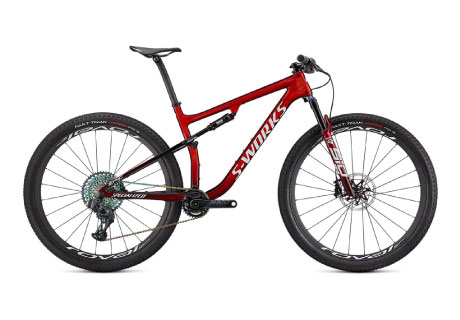
What height is a 29 inch bike for?
Any adult can ride a mountain bike with 29” wheels, but 29ers are the ideal choice for taller riders over 5’7”. The large diameter wheels can feel a bit unwieldy or bulky for shorter riders or riders who aren’t as confident on the trails. Many brands put 29ers on larger frame sizes and 27.5” wheels on small frames to offer a consistent bike fit.
More on 29 inch mountain bikes
The bigger diameter of 29” wheels allows them to reach higher top speeds, roll over large obstacles, and increase stability. Larger wheels have a smaller angle of attack when they come in contact with a rock or root out on the trail and can more easily roll over obstacles. 29ers are the go-to size for downhill mountain bike races where riders need to maintain high speeds over rough terrain.
The larger contact patch of a 29” wheel also means more traction and grip, but not necessarily while cornering. The disadvantage of big wheels is that they can be less agile and responsive while turning or executing quick maneuvers. Check out our catalog and shop 29 inch mountain bikes.
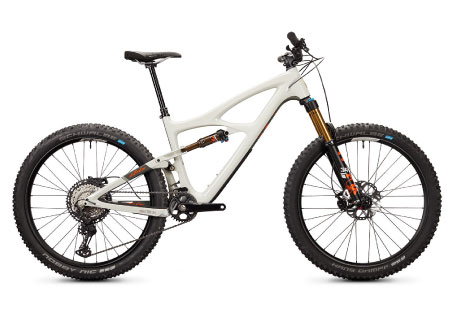
What height is a 27.5 inch bike for?
27.5 inch bikes are suitable for adults between 5’2” and 5’10”. That said, adults of all heights can ride this wheel size. Some brands claim that 27.5” wheels are especially useful for riders 5’7” and under.
More on 27.5 inch mountain bikes
Bike manufacturers like Trek and Giant have realized that matching smaller wheels to smaller frames can make for a better overall fit. Trek’s Smart Wheel Size approach pairs 29” wheels with M, L, and XL frames and puts 27.5” wheels on XS and S frame sizes.
27.5” wheels are more agile and responsive on technical terrain when compared to their 29” counterparts. They are big enough to roll over obstacles better than 26” wheels and small enough to provide nimble handling. As long as you’re not doing intense downhill riding, 27.5” wheels are the ‘goldilocks’ middle wheel size compatible with most terrain and rider heights.
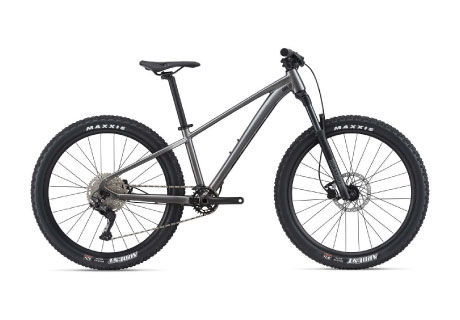
What height is a 26-inch mountain bike for?
A 26” mountain bike is the ideal set-up for younger riders or shorter adults who are between 4’10” and 5’5”. This smaller size is also great for riders that are not as confident on the trails. The smaller diameter 26” wheels are more agile out on the trails and are easier for shorter riders to maneuver over tricky terrain.
More on 26 inch mountain bikes
26” is the most common mountain bike wheel size on old school bikes, many of which are still around today. If you are on the hunt for a retro bike or are fixing up that bike in the garage, odds are it’s paired with a 26” wheelset. Remember that back in the day almost all mountain bikers regardless of height rode bikes with 26” wheels, so if that’s what works for you, feel free to buck the current trend of larger rims.
Bikes designed for dirt jumping utilize 26” wheels with strong alloy rims to handle landings after getting some serious air. Smaller wheels are stronger because they have shorter spokes, making the link between hub and rim less vulnerable to deforming under stress.
Large kids bikes utilize 26” wheels as the last step before tweens are ready to make the jump to adult sized bikes. Kids can continue to build up their riding confidence and skills on 26” wheels and switch later on to bigger mountain bikes.
Is it better to size up or down on a mountain bike?
Size up if… you are a skilled rider or prioritize stability on fast descents.
Choose the smaller size if … you are a less aggressive rider or desire a more upright riding position and nimble bike handling.
If you find yourself between sizes on mountain bike size charts, additional metrics and rider preferences can help you figure out your perfect size. Bike size charts are simply suggestions and are often based on a single height measurement, so they fall short of telling the whole bike fit story. Follow this advice to pick the correct size when you’re right on the edge of two frame sizes.
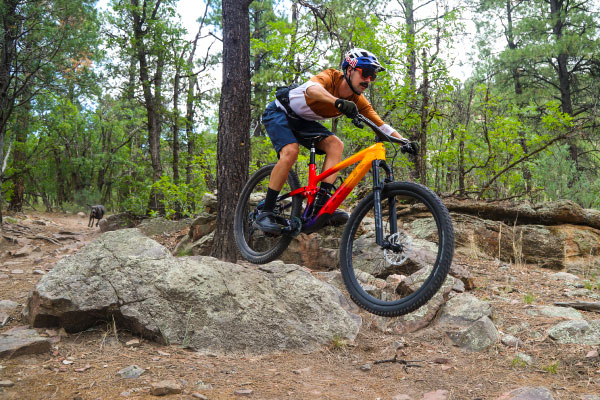
When to size up on a mountain bike
Going a size up means a longer bike with more space between the pedals and handlebars and bigger range of motion when standing up on the pedals.
This extended set up is best for riders with relatively long torsos or who are flexible enough to handle the longer reach.
Bigger bikes will naturally have a slightly longer wheelbase. Wheels farther apart means the bike will be more stable at high speeds and feel hefty rather than nimble on technical trails.
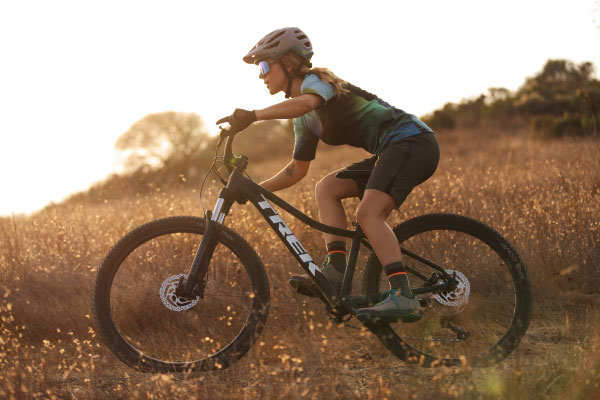
When to size down on a mountain bike
Sizing down is the right option for people that want a more relaxed, comfortable riding position or like agile and responsive bike handling.
Smaller frame sizes have a shorter reach so the handlebars are closer to the seat, placing the rider in a more upright position. This is ideal for less flexible riders or riders with relatively long legs compared to their torso.
The slightly shorter wheelbase provides a more nimble and zippy ride feel. As a less aggressive set-up overall, a smaller frame is the right choice for beginner to intermediate riders.
How mountain bike geometry affects bike size and fit
The overall shape and geometry of a mountain bike is composed of many specific measurements beyond just the frame’s size. Some of the most important measurements to pay attention to when it comes to size are reach, wheelbase, standover height, and stack. These dimensions make a big difference to how a bike will fit your body and perform on certain terrain.
There can be a little bit of number crunching when it comes to frame geometry, but understanding these metrics is key to getting the most out of your bike. There’s plenty to geek out on but don’t worry, we won’t go too far down the rabbit hole.

Reach on a mountain bike frame is the horizontal distance between the bottom bracket and the center of the head tube. Basically it tells how much room there is between where your feet go and where your hands go on the bike and how much range of motion the rider has while pedaling.
Reach determines how far riders need to lean forward to grab the handlebars while standing on the pedals. MTB riders are frequently standing out of the saddle on descents or while climbing steep sections. Riders need sufficient room to maneuver on technical terrain, but not so much that they are too stretched out. Reach is the most important metric to pay attention to because it changes the between frame sizes.
Too much reach and you’ll be leaning too far forward while in the normal riding position. Short reach means the handlebars are relatively close to your body— riders can feel overly upright with not enough weight over the bottom bracket to pedal efficiently.
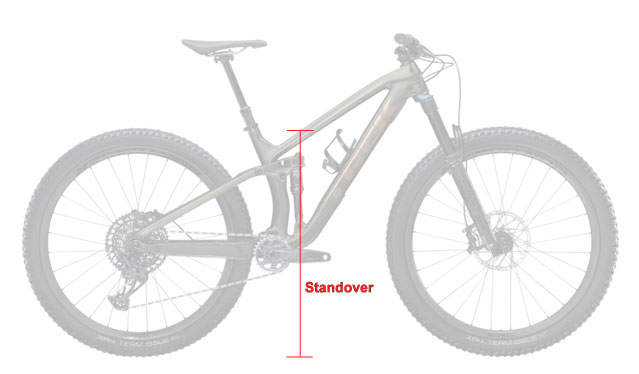
Standover height relates to how high the top tube is when you are straddling the bike with your feet on the ground. It’s like when you stop at a stop sign and hop off the saddle to stand over your bike frame— there should be at least 2” of clearance between the top tube and your groin.
Standover height is more important for road bikes than it is on modern mountain bikes. MTB frame designs today have quite low standover heights, so it’s never a worry that it’ll be difficult to swing your leg over the frame to mount the bike or that you won’t be able to comfortably straddle the frame. That said, always check you have enough clearance to allow for quick and safe dismounts.
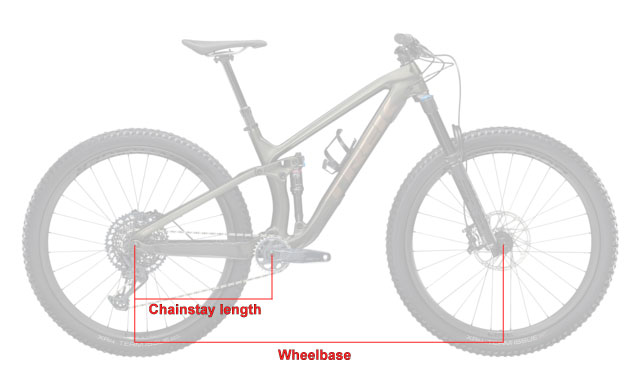
Wheelbase & Chainstay Length
Wheelbase is the horizontal distance between the front and rear axles on a mountain bike. How far apart the wheels are is a major factor that determines whether a bike feels more stable or more nimble.
A longer wheelbase is more stable and is easier to control at high speeds, useful for steep descents or fast trails. Shorter wheelbases means the bike is a bit more compact and will be more maneuverable on technical terrain and around tricky obstacles.
Since wheelbase is essentially a measurement of the frame from one end to the other, wheelbase is made up of other metrics like reach, head tube, angle, and chainstay length added together. It’s important to recognize where the extra length (or lack thereof) is coming from to understand how the overall bike will feel out on the trails.
Chainstay length, or rear center, is another measurement to look at. Chainstays connect the bottom bracket to the rear axle, and longer chainstays provide more stability at speed, while shorter ones feel more nimble. Some models utilize the same chainstay lengths across the size range, but not all.

Stack is the vertical distance between the bottom bracket and the center of the head tube and determines how a bike will feel while pedaling in the saddle. While still an important metric to consider, stack doesn’t change as much as reach does between frame sizes.
Stack gives riders a clue on how high up the handlebars will be relative to the pedals. If stack height feels too high or low, it can be adjusted with headset spacers or handlebar rise to fit the specific rider.
Let us help you find the right size mountain bike
Even with all the information and advice out there, there’s nothing like test riding the real thing. If you’re still undecided on which size is right for you or want some additional assistance, our bike experts are ready to help.
Visit one of our three Calgary area locations to test ride a mountain bike and find the perfect match. Whether you are seeking performance gains or recovering from an injury, explore the fitting services we offer to achieve a precision bike fit.
Explore Our Top Mountain Bike Brands


Mountain Bike Size FAQs
Why do some mountain bike frames use inches for sizing.
How to size a mountain bike has changed and bikes today are categorized according to alpha sizing (think: S, M, L, XL) rather than the length of the seat tube.
Traditionally, frame sizes were listed in inches, but modern mountain bike designs with their low standover height and diverse geometries prevent seat tube length from being a representative measurement. Bike brands have realized that “size S” is much more intuitive for customers than listing a frame as “15 inches”.
Many bike manufacturers have moved away from gender-specific designs and, instead, offer their bikes in a variety of sizes to fit any rider. For that reason, most brands don’t provide a women’s mountain bike size chart. The mountain bike frame size chart above works well for all types of riders regardless of gender or height.
What size mountain bike should I get for my height?
Riders under 5’5” fit best on either S or XS mountain bike frames, depending on which of those sizes are available. If you are between 5’6” and 5’10”, choose a size M. Riders 5’11” and taller should get an L or XL frame. Check out our mountain bike size chart for an exact recommendation.
What size mountain bike do I need if I'm 6 feet tall?
Riders that measure 6’ tall should ride a size L mountain bike frame. Some bikes use seat tube length instead of alpha sizing to measure their size. Look for a frame size marked between 19” to 20”.
How do you size a mountain bike?
Modern mountain bikes use alpha sizing to categorize frames as XS, S, M, L, or XL. Older mountain bikes used seat tube length, or the vertical distance from the bottom bracket up to the seat post clamp. Check out our mountain bike size chart or the sizing tools on a brand’s website to determine the correct size for you.
How do you measure yourself for a mountain bike?
The most important measurement to take is rider height. Take an updated measurement of your height (or have a friend help you) and compare it to our mountain bike size chart to find out which frame size works best for you.
What size is a medium mountain bike?
A medium mountain bike typically has a frame size of between 16” to 18”. Medium bike frames can fit riders between 5’6” and 5’10”.
Is a 19 bike frame a large?
A 19” bike frame is typically rated as a large frame, appropriate for riders between 5’10 and 6’2”. Depending on the manufacturer and specific model, large bikes can have frames that measure 19”, 19.5”, or 20”.
Is my mountain bike too small?
Feeling cramped, high knees while pedaling, and sitting too upright can be signs that your bike is too small. The reach, or horizontal distance from the bottom bracket to the center of the head tube, should be long enough that you can have a good range of motion both in and out of the saddle.
- MAGAZINE OFFERS
- BIKE INSURANCE
- Best Products
- Maintenance
- Accessories
- Long-Term Reviews
- BikeRadar Podcast
- First Look Friday
- Bike of the Week
- Tech Features
- Routes and Rides
- Bike Galleries
- BikeRadar Bargains
- Buyer's Guides
- Fitness & Training
- Sizing & Fit
- Mountain Biking UK
- Cycling Plus
The ultimate guide to bike sizes: road, MTB, gravel and hybrid sizes explained
BikeRadar's beginner's guide to finding the right size bike
Paul Norman
One of the most important things to get right when choosing a new bike is the frame size.
Although there’s a lot you can adjust on a bike so that it fits better, if you start off with a frame that’s too small or too large for you, you may be placed awkwardly and uncomfortable as you ride.
That can result in aches and pains when cycling and your bike not handling as it should, both of which can have a negative impact on your enjoyment.
With that in mind, here’s everything you need to know about bike sizes – be it a mountain bike, road bike, hybrid bike, women's-specific bike or child’s bike.
How are bike sizes measured?
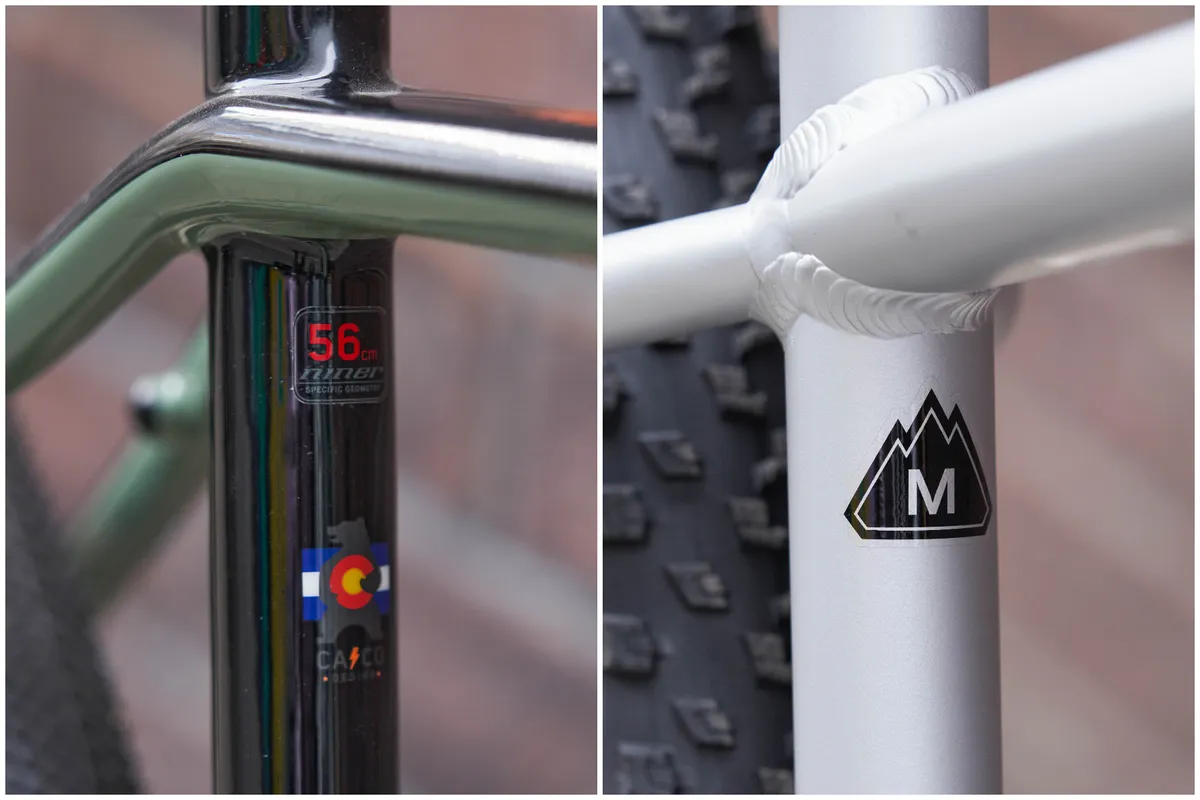
Bike sizes are measured in a number of different ways and, confusingly, there’s little consistency between bike types or between brands.
Road bike sizes are typically measured in centimetres, based on the length of the seat tube (from the bottom bracket to the top tube), although as we’ll see the actual seat tube length will vary dependent on the frame geometry.
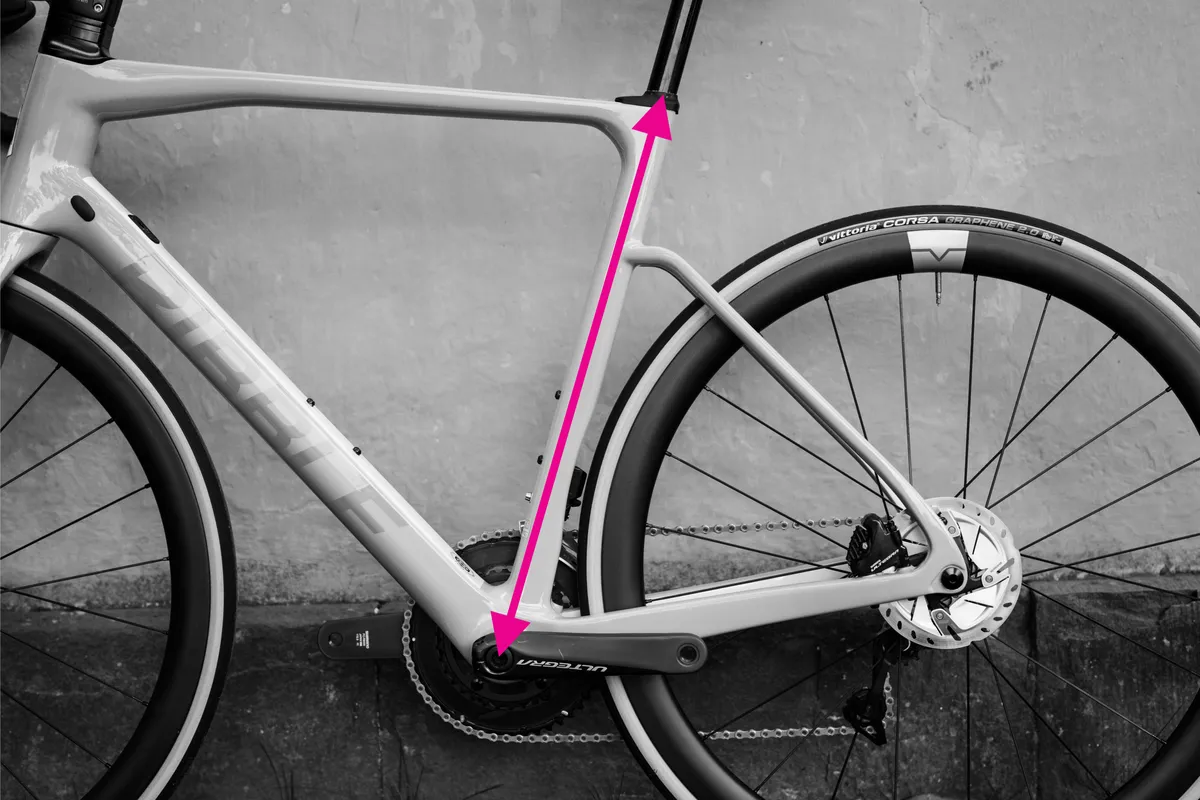
On the other hand, mountain bike frame sizes are typically measured in inches, because they originated in the US.
You can’t compare mountain bike frame sizes directly to road bike frame sizes – not just because they’re in different units of measurement, but also because the frames on mountain bikes usually have much shorter seat tubes than those found on road bikes .
To get around the difficulty of measuring frame sizes, some brands use T-shirt sizing (e.g. S, M, L) for all their bikes, based principally on rider height.
But again, this measure isn’t consistent between brands. Indeed, brands that sell both road and mountain bikes may use a different sizing convention between the two.
Children’s bikes use different sizes again, often based either on a child’s age or the bike’s wheel size.
How to find your bike's size
If you have a current bike, you can look at the frame size sticker on it to find what size it is. This will often be located on the seat tube, but might be in a more discreet location, such as under the bottom-bracket area.
If it’s a recently sold model, you should be able to find a geometry chart for your frame on your bike brand’s website.
Alternatively, you can measure your frame size yourself, as we explain in this piece on how to measure a bike frame .
How do I know what size bike I need?
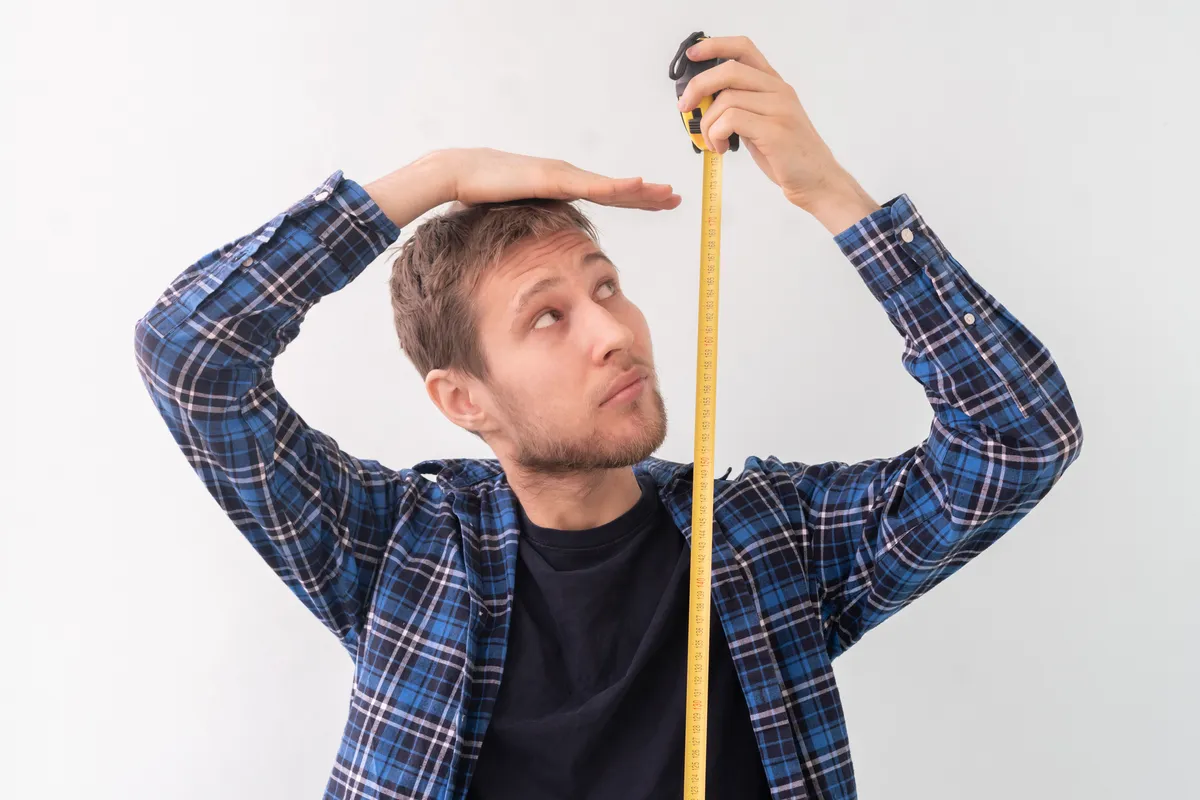
There are a number of ways to find your correct bike size.
1) Rider height and inside leg
The quickest is often to look on a brand’s site.
Usually, there will be a size chart with recommended bike sizes for different rider heights, so it’s comparatively easy to see where you fit.
Some brands will have an interactive size guide, where you input your height and often other details, such as inside leg length, to find your recommended size.
However, don't take a brand's size guide as gospel – it's a guide, after all, and one person's dimensions and requirements can vary from another, even if they are the same height.
Equally, if you are between sizes, you will need to decide whether to size up or size down. More on that to come.
2) Go to your local bike shop
Next up, if you’re buying a bike from a physical shop, you can ask them what size you need. Sometimes you’ll just get eyeballed and the assistant will put you on a bike to see if you fit.
However, bike shops are getting more sophisticated, so you might get a proper sizing where the shop staff will measure you and determine more precisely what size bike you need.
Find a good local bike shop that takes the time to ensure you’re buying the right size bike.
3) Bike fit
Finally, some shops will offer you a discounted or free bike fit as part of your purchase. This is the most sophisticated option, not just to make sure you get a frame that fits, but to have your contact points set correctly so you'll be comfortable and efficient when riding.
You may be advised to swap out components such as the stock saddle for something that better suits your sit bone anatomy or to opt for a non-standard bar width or stem length , for example.
A bike fit will also help you to determine key setup measurements, such as saddle height, which are crucial to finding a comfortable and efficient riding position. We’ll cover this in more detail later.
What if I'm between sizes?
There’s normally an overlap between frame sizes, so you’ll often have a choice of two sizes.
If you sit between two frame sizes, the normal advice is to take the smaller of the two options. There’s a lot you can adjust easily on bikes, such as saddle height and handlebar height , to fine-tune the fit.
However, seek further advice from the bike brand or your local shop, if you're unsure.
Bike size chart
We’ll cover the nuances of road bike, mountain bike, hybrid bike and gravel bike sizes shortly, but here’s an overview of typical frame sizes, according to rider height.
However, body dimensions and frame layouts can vary significantly from one person and brand to the next, so seek further advice, specific to the bike you are intending to buy, before purchasing.
Road bike size guide

The most common way of sizing road bikes is by seat tube length in centimetres.
However, this will be different depending on whether the frame has a sloping or a horizontal top tube, so you’ll often see 'effective' seat tube lengths quoted, based on a horizontal line between the head tube and the seatpost.
Some brands just give you S, M, L (and often XS and XL) sizes. Others, such as Colnago and Pinarello, have their own unique sizing systems.
That means you’ll need to revert to the brand’s size info, as described above, or study the road bike’s geometry chart to work out which bike size is best for you.
See our guide to road bike sizing for more detailed information.
Mountain bike size guide
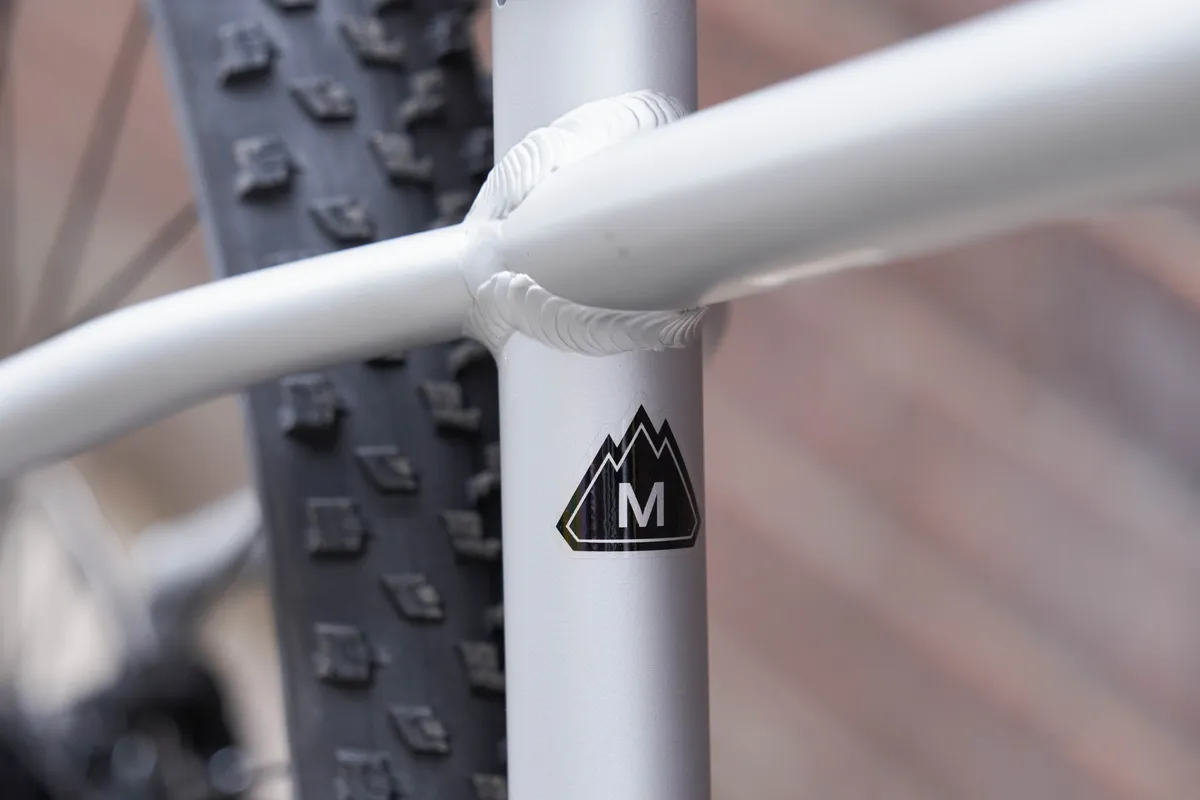
When it comes to mountain bike sizing , most brands have reverted to an S, M, L (etc) sizing method for their frames.
With mountain bike seat tube lengths being highly dependent on the frame geometry and rear-suspension layout, T-shirt-style sizing provides the clearest guide.
The trend for long and slack mountain bike geometry has accentuated the difficulty in selecting a frame size based on seat tube length alone and some brands now rely on reach (the horizontal distance from the centre of the bottom bracket to the top of the head tube) to define their frame sizes.
Seat tube length is still an important consideration though, because you need to be able to get your saddle height right. If you want to fit a dropper post , a short seat tube may also mean some models won't fit.
Finally, MTB frame sizes are significantly smaller than for road bikes, so don’t try to compare your road bike and mountain bike sizing.
We’ve got a lot more info in our mountain bike sizing guide.
Mountain bike sizing, geometry and riding style
It’s a good idea to study our guide to mountain bike geometry to understand the key measurements of an MTB frame, and how they affect a bike’s handling characteristics and fit.
The type of riding your bike is designed for alters its geometry, too. If you’re riding a cross-country bike , designed for agile handling, you may want to be more stretched out, while beginners may prefer a shorter reach so that they’re more upright, with less strain placed on the hands and wrists.
Bikes designed for more aggressive riding, including the latest downcountry bikes , trail bikes and enduro bikes , will typically have a longer, slacker geometry to match, which may have a knock-on impact on finding the correct frame size.
With the trend for bikes to have slacker head tube angles, it’s important to get your position forward enough to weight the front wheel and the suspension effectively, so you don’t want a frame and seat position that sits you too far back. Again, a geometry chart is the best way to work out the best frame size for a comfortable fit.
Gravel bike size guide
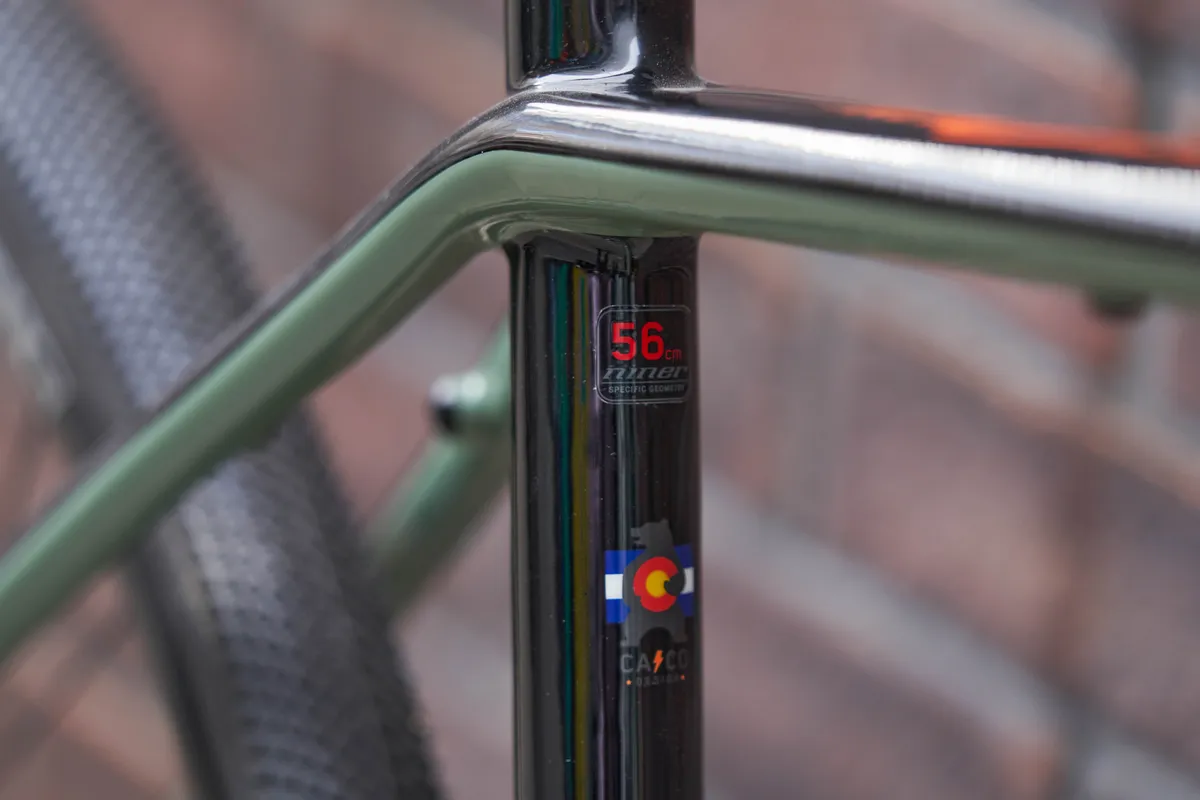
Gravel bike sizing is much like road bike sizing, with most brands using the seat tube length in centimetres to size frames, though T-shirt-style sizing is, once again, also used by some brands.
In general, your position on a gravel bike will be more relaxed and upright than on a road race bike.
That’s because you need to be able to shift your weight around more off-road to balance and steer your bike over obstacles. A more upright position will also be more comfortable over uneven terrain.
Having said that, if you’re interested in gravel racing , a longer and lower position will reduce your frontal profile and potentially make you faster, and the geometry of many of the latest go-fast gravel bikes is shaped accordingly.
As when choosing a road bike, pay attention to the geometry of a gravel bike when choosing your next ride. Buying a bike that matches your riding intentions is vital.
Women’s bike size guide
Women's frame sizes can vary significantly depending on a brand's outlook on women's bikes.
Some brands, such as Liv, have women’s-specific geometry and women’s bike ranges designed from the ground up. As a result, the range of sizes on offer will also be specific to women.
Other brands, meanwhile, assert that there are more differences in body proportions among people of the same sex than there are between sexes, and label all their bikes as unisex as a result, following a 'unisex' size guide.
In the middle, you have brands that offer 'unisex' frames but with specification tweaks to cater for women.
Some brands – such as Canyon, on its women's-specced WMN road bikes – fit smaller 650b wheels to their smaller frame sizes, so that geometry and handling can be kept consistent through the range.
We’ve got a separate guide to women’s bike sizing to cover the topic in detail, including the difference between road, mountain and hybrid bike sizes for women.
Kids’ bike size guide
As with adult bikes, it’s vital to get the size correct for a child's bike.
Age range is often quoted by bike brands as a way to size kids’ bikes but, because children grow at different rates, it’s not the best way to make sure a bike will fit comfortably.
Measuring your child

Measuring your child is an important first step in choosing the right kids’ bike size.
That starts off with their inside leg measurement. You also need to measure their height.
For the majority of the best kids’ bikes , that should give you the info you need to hone in on the correct bike size.
Wheel sizes
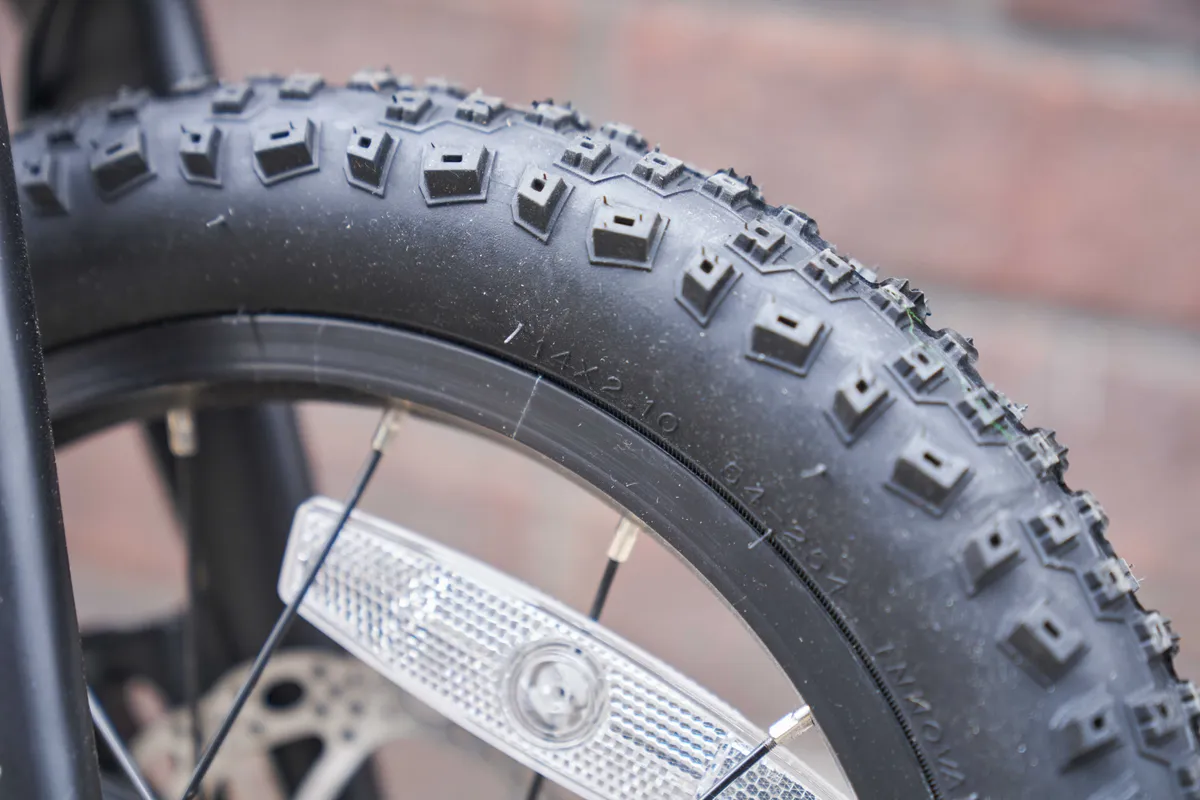
As we cover in our kids’ bike size guide , children’s bikes are normally sold by wheel size (in inches), with sizes increasing from 12-inch balance bikes, via 14in, 16in, 20in, 24in and 26in.
What if a child is in between sizes?
It’s tempting to buy a size up so that they’ll grow into it in a few months. That’s not optimal, not least if you're teaching a child to ride a bike for the first time.
If they’re not able to ride the bike comfortably and put a foot down easily, they may feel nervous, lose confidence, and be put off riding. It’s also easier for a child to overbalance and have a fall if the bike is too large for them.
Some brands have trade-up schemes with a discount on a larger bike when they’ve grown out of their current one.
Share this article

- Terms & Conditions
- Subscribe to our magazines
- Manage preferences
Trek Bikes Size Guide
Need to know what frame size you need for your next Trek bike? Checkout the sizing chart below:
To view the latest Trek Bikes: click here.
This chart use measurements suggested by Trek Bikes:
- Trek Remedy Size Guide Chart
- Trek Slash Size Guide Chart
- Trek Fuel EX Size Guide Chart
- Trek Rail Size Guide Chart
- Trek Fuel EXE Size Guide Chart
- Trek Powerfly Size Guide Chart
- Trek Top Fuel Size Guide Chart
- Trek Proclaimer Size Guide Chart
- Trek Supercaliber Size Guide Chart
- Trek X-Caliber Size Guide Chart
- Trek Allant+ Size Guide Chart
For further advice about sizing please contact us using the form below
- "I purchased my first EMTB from MTB Monster in December, having taken advice from people I found the Cube bike I was looking for in their store. From the first phone call through to collection the staff who ever answered the phone were polite, professional, knowledgeable…." Nigel January 2024 (Google Review)
- "Bought my new Trek from MTB Monster online. Went into the showroom previous to this and the staff were friendly and helpful. Real good quality service from point of order to picking my bike up… On collection the bike was ready and looking good and the guy ran me through all I needed to know and answered my questions." Daniel May 2023 (Google Review)
- "Ordered a Cube reaction electric mountain bike from MTB Monster, Excellent service from them. Great price for the bike, communication was brilliant and it came quickly and very well packaged. Would recommend to anyone. Thanks." Arty October 2023 (Trust Pilot)
- "Couldn't be happier with the sales service from MTB Monster when buying a new bike online recently. They were quick and helpful to in answering questions about the bike, and the sales, comms and shipping process were super smooth and reassuring. Would definitely buy again and recommend to others." Russ January 2024 (Google Review)

Connect with us on social media

Biketoworkday is supported by its audience. When you buy through our links, we may earn an affiliate commission. Learn more
Bike Sizing Guide: What Size Trek Bike Do I Need?
Written by Gary Johnson / Fact checked by Henry Speciale
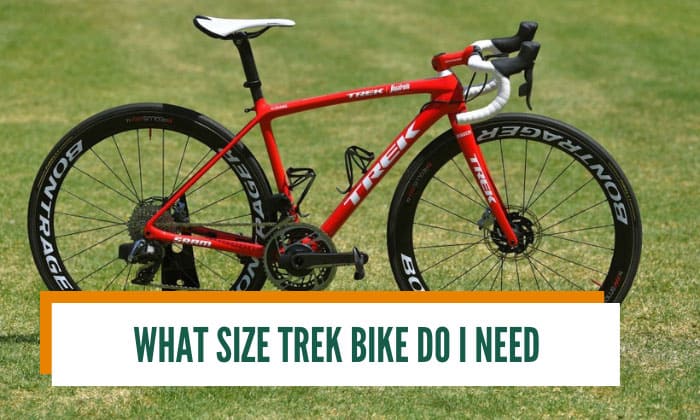
Are you looking for a bike to buy and asking yourself “what size Trek bike do I need?”
Trek bike sizing is very straightforward and varies by type.
For example, mountain bikes follow a unique method called alpha sizing that uses designations such as small, medium, or large. Using this system, a 5’3” to 5’7” tall person can use a 17.5” frame size.
On the other hand, Trek road bike sizing takes into account the inseam length.
If you want to get on the road or hit that trail with your ideal two-wheeler, check out our sizing guides below.
Table of Contents
1. Trek Mountain Bike
2. trek road bike, 3. city & hybrid bike size chart, things you can consider before choosing a trek bike size, helpful tip, trek bicycle sizing guide.
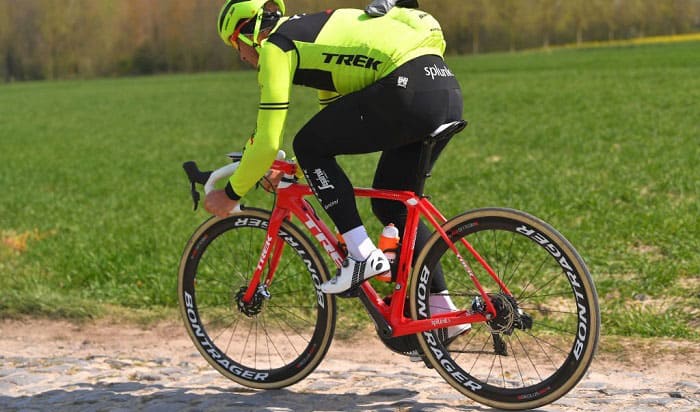
Trek bikes are comfortable and easy to ride, making them excellent for beginners. They also come in different dimensions, so you should find one that fits you perfectly.
Whether in inches or cm, our Trek bike size chart will help you match your height with the appropriate vehicle.
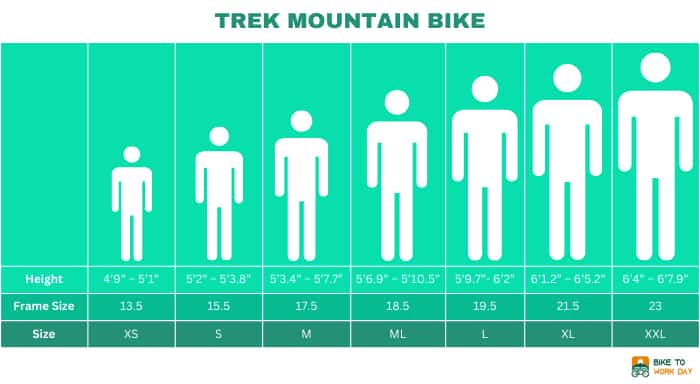
Unlike other brands, Trek bikes have upgraded their MTB sizing with alpha classifications to remove guesswork for customers.
You may find that your chosen model has some and not all of the sizes in this Trek MTB size chart. In that case, branch out and look for XS and XXL options if the Trek M/L frame size doesn’t fit you.
Note that the women’s bike size chart also uses the alpha sizing guide for their line of women’s mountain bikes though the height requirement is slightly different for each size.
Did You Know
The Trek Marlin 5, which is a popular trail mountain bike, uses the alpha sizing chart, but its size is not limited to XS – XXL only! Trek also offers an XXS with 26” wheels for this MTB type.
Trek has given us 4 categories when it comes to road bicycles. These include:
- Aero – The best aerodynamics for speed and performance
- Endurance – Provides comfort perfect for long hours of riding
- Time Trial – Speed-focused bikes with unique designs
- Climbing – Lightweight bikes excellent for uphill climbing
Designed to be a mixture of road and mountain bikes, Trek hybrid bicycles are best used for casual rides and commutes.
What size bike should I get? What does “size” really mean? And what is the best way to find the correct model for yourself?
There are usually FOUR different aspects that you must consider and have a good idea about.
Riding Style

Do you want to ride your bike for fun or use it for racing and exhibition? Regardless of your budget, it is important that you consider the type of biking you want to do. Some people prefer to ride in the city, while others prefer to cycle off-road.
Trek bikes come in various sizes depending on the vehicle’s discipline, since some frames have different geometry to provide the support their riders need.
Rider Height
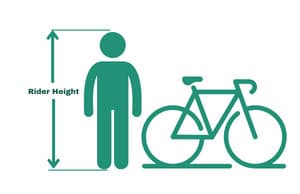
Most bicycle models come in different sizes for different body types so that they fit most people well.
The height of a person, when measured from head to toe, can help determine the bike size that would match them. This is because taller people have longer upper and lower extremities compared to shorter people, which means they will need different sizes of bikes in order to ride comfortably.
Inseam Length

After careful deliberation with the above two factors, the frame size is then ultimately determined by your inseams or the distance from your crotch to the bottom of your leg.
You should take this into consideration because it will determine how much room there is between your feet and handlebars when sitting on the saddle comfortably.
Practical Use /Test Ride

Last but not least, once you have chosen your bicycle size and Trek model, test out the bike with at least a short ride. This will let you assess the balance and comfort of the chosen vehicle.
Whether you ride recreationally or professionally, you cannot choose blindly. First, bikes are expensive, and second, you must buy the correct product to use it for a long time.
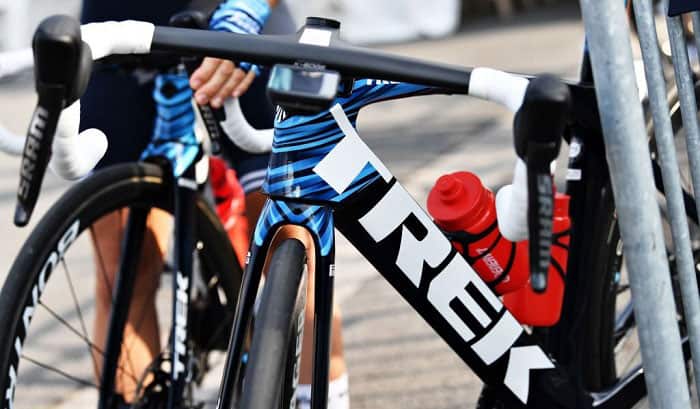
If you’re done with our Trek frame size chart, Trek’s online website also has a unique feature that helps you select the correct frame size. You can try their bike finder, which asks for your riding style, height, and even inseams before arriving at a recommendation.
In case you haven’t noticed, there is a lot of variation in bicycle sizing, and looking for the size I need for my height was not a walk in the park.
Well, I hope our guide answered your question about what size Trek bike do I need. Should you have any more questions, send us a message.
Read more: Choosing the Ideal Bike Size for Your Kids – Bicycle Sizing Guide.

“I ride my bike to work for years, but is that enough? Our carelessness towards our surroundings has taken a toll on the environment. And now, everyone is responsible for changes; even the most minor contribution is counted. With this hope and spirit, I started with my partner to establish Biketoworkday to help more individuals commute to their work sites on their bikes.”
Bike Station Blog
Mountain Bike Size Chart
- Post author By Bike Station
- Post date February 5, 2022
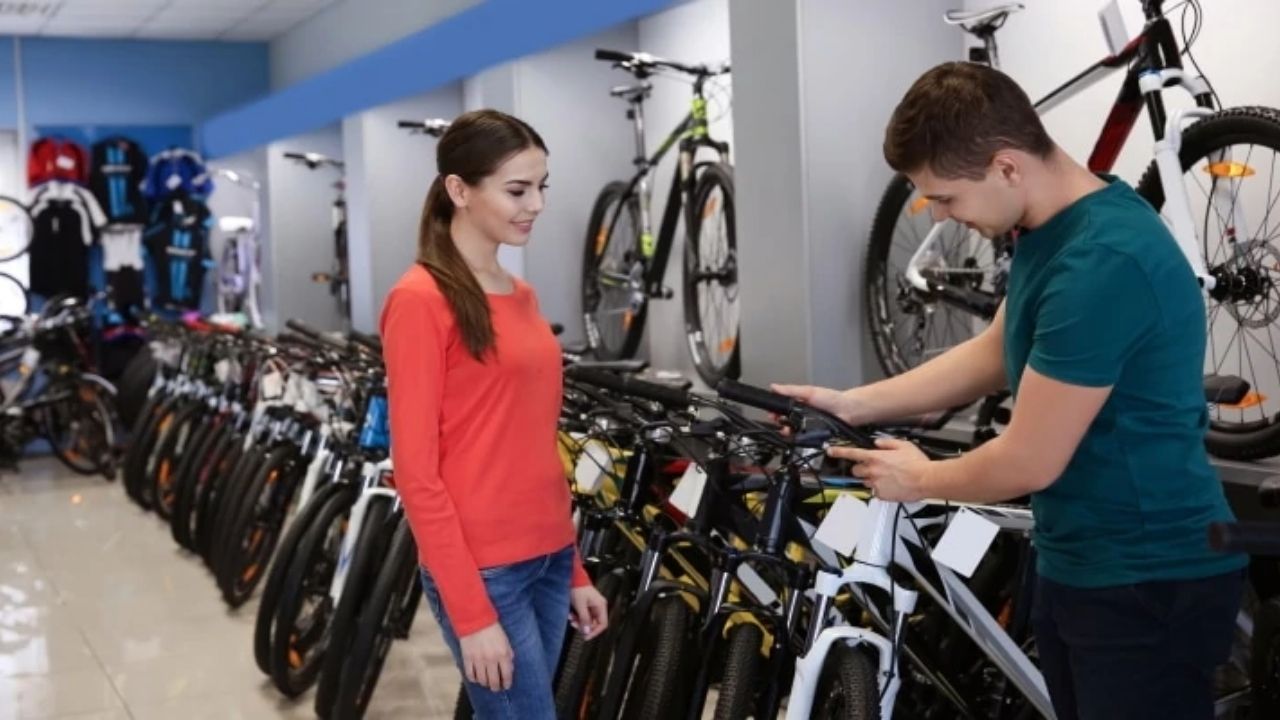
The size of a mountain bike is as important as its features. Having the wrong size and fit reduces comfort, efficiency, and, most importantly, the amount of fun a bike can provide. Therefore, a mountain bike size chart is crucial when choosing your new mountain bike.
It might not always be easy to find the right size, especially because every person has a different body size. To make things worse, it does not end at big and small. People have varying body proportions; for example, two people of the same height may have different arm or leg lengths. Choosing the perfect bike involves selection based on frame size, geometry, and a couple of other factors – let’s check them all out here.
Page Contents
Frame size is the first thing to check when you want to find the right size of the bike. Most manufacturers offer a variety of frame sizes from extra-small up to extra-large. The selection of frame size can be done based on rider height and inseam length. Your inseam length is the distance from the ground to your crotch. Here’s a useful bike size calculator chart to help you determine the right size of frame based on these two factors:
We also have a general bike size chart if you are looking to size a different type of bike. Don’t forget to check our page on sizing your child for a bike , if you are getting a new bike for your younger one.
The frame size letter will correspond to the size in inches as shown on the bike frame size chart in most cases. However, some manufacturers may have a different size range, meaning an L frame may be an M, or an S an M. It is good practice to always check the numbers instead of the letters. Some companies may even provide frame size in centimeters, like road bike frames. It is unlikely, however, that manufacturers will mention frame size in feet.
The mountain bike frame size chart given above is generic and can be considered unisex. However, some brands have different bike models for female riders, owing to different body proportions. The manufacturer will provide a men’s mountain bike size chart and a women’s mountain bike size chart separately in such a case.
If you find yourself between two frame sizes, choose the larger frame size if you have a longer torso or longer arms. A larger frame also provides an aggressive riding position. If you prefer a more upright position or have shorter arms, go for the shorter mountain bike frame size.
Wheel size is another important factor to look for when figuring out the right bike size. Adults’ mountain bikes generally have wheel diameters ranging from 26” to 29”. Some manufacturers provide the same model in smaller sizes with 26” wheels and medium or larger sizes with 27.5” or 29” respectively. This is not exclusive to expensive bikes and even applies to mountain bikes under $1000 .
Someone with a larger body might find larger wheels more comfortable. A larger tire size also helps roll over small obstacles relatively easily. The suggested frame height will always have a suitable wheel size for your height, which will often also be mentioned on the bike size calculator provided by the makers.
Frame Geometry
The mountain bike fit chart shown in the previous section is a great first step when you set out to find the right mountain bike frame size, but it might not be the last. Frame size is the length of the seat tube. Different manufacturers have different frame geometries, meaning the proportions between the seat tube and top tube or their angles may differ significantly.
You should also look at the bike’s geometry, even after ensuring you have the right frame based on the bike fit calculator.
Once you have selected the suggested frame size, the next important measurement to consider is the top tube height. The geometry charts might not be of much help here. You should be able to comfortably stand over without pressing against the top tube. You can try standing over the bike to make sure the top tube is not too high.
Once you are sure about the standover height, make sure the top tube length is correct. People with shorter arms may find it difficult to reach the handlebar from the seat comfortably. If the top tube on a certain bike is too long, try looking for another one that has a shorter reach. For minor adjustments, you can move the saddle forward or backward; however, moving it too much can make the ride less comfortable.
The reach may also be affected by the kind of bike you buy. For example, one with a longer suspension fork will have a different handlebar position.
Saddle height
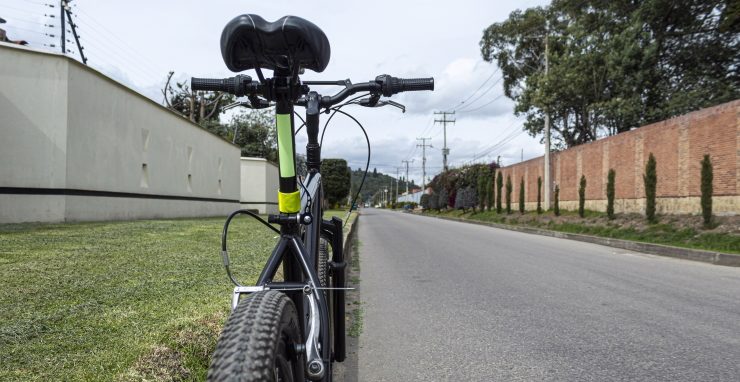
Getting the right size and geometry in a bike frame wins you only half the battle. The next important part is adjusting the bike to your body. This can only be done once you have bought the bike, and mere size guides won’t help much. Even with the correct mountain bike frame size, you might need to make a few tweaks to maximize comfort and efficiency.
Saddle height is the most important among these adjustments. A saddle that is too high will cause difficulty in pedaling along with back pain issues, and a saddle that is too low will reduce comfort and your ability to push the pedal with enough power.
Adjust your saddle height to be high enough so that your leg is almost straight when the pedal is at the farthest position. The ideal way is to have a 15-20° bend in your knee.
Handlebar Position
Adjusting the handlebar position is something that may not occur to everyone, but even with the minor change of position it offers, you can experience a whole new level of comfort. Moving the spacers on the stem or inserting new ones to raise the handlebar can offer a more upright position. Some manufacturers even offer adjustable stems that can be moved up or down, changing the handlebar height.
The handlebar can even be moved horizontally by controlling the stem length. If you go for a shorter stem, you can move the handlebar closer, while a longer stem pushes it farther. This gives you the ability to adjust your reach without changing the saddle position too much.
Together, the saddle height and handlebar position can significantly impact how your bike feels and rides. If you plan on doing professional riding, you can even consider getting a professional bike fit done for a flawless, perfect fit. But for recreational riding, adjusting your bike settings on your own is sufficient and can even be fun in the sense that you get to learn something new.
For some, another criterion may be the weight. If you are between two sizes, you can check the difference in weight and go with a smaller frame for a lighter bike. Steel frames are heaviest, while aluminum frames are much lighter. Carbon-fiber frames are the lightest but are expensive. Anything available for under $2000 will be mostly aluminum or steel.
Having the correct bike size is crucial, as an incorrect size can affect everything from comfort to overall health in the long term. This comprehensive bike fit guide should help you make the right choice, whether you are looking among the top mountain bikes for less than $500 or willing to spend thousands.
- Categories Categories: Guides & Information
Be the first to hear about bike news!
I agree to receive emails from Bike Station.
We're here to help you with your bike sizing and cycling apparel sizing needs.
Sizing charts
Use the "sizing & fit" link at the top of any product page to find the size that's best for you.
Fit technicians
If you fall across two sizes or have questions about the bikes size that will best suit you, see the expert fit technicians at your local retailer.
- Mountain bikes
- Hybrid bikes
- Kids' bikes
- Women's bikes
- Men's apparel
- Women's apparel
- Cycling shoes
- Cycling helmets
- Cycling gloves
- Cycling socks
- Cycling warmers
- Apparel fit guidelines
Statue of Lenin

Most Recent: Reviews ordered by most recent publish date in descending order.
Detailed Reviews: Reviews ordered by recency and descriptiveness of user-identified themes such as wait time, length of visit, general tips, and location information.
Statue of Lenin - All You Need to Know BEFORE You Go (2024)
- (0.57 mi) Elektrostal Hotel
- (1.00 mi) Yakor Hotel
- (1.31 mi) Hotel Djaz
- (1.41 mi) Mini Hotel Banifatsiy
- (1.45 mi) MTM Hostel Elektrostal
- (0.07 mi) Teremok
- (0.21 mi) Coffee Shop Usy Teodora Glagoleva
- (0.25 mi) Mazhor
- (0.30 mi) Tashir Pizza
- (0.31 mi) Ermitazh

- Bahasa Indonesia
- Eastern Europe
- Moscow Oblast
Elektrostal
Elektrostal Localisation : Country Russia , Oblast Moscow Oblast . Available Information : Geographical coordinates , Population, Area, Altitude, Weather and Hotel . Nearby cities and villages : Noginsk , Pavlovsky Posad and Staraya Kupavna .
Information
Find all the information of Elektrostal or click on the section of your choice in the left menu.
- Update data
Elektrostal Demography
Information on the people and the population of Elektrostal.
Elektrostal Geography
Geographic Information regarding City of Elektrostal .
Elektrostal Distance
Distance (in kilometers) between Elektrostal and the biggest cities of Russia.
Elektrostal Map
Locate simply the city of Elektrostal through the card, map and satellite image of the city.
Elektrostal Nearby cities and villages
Elektrostal weather.
Weather forecast for the next coming days and current time of Elektrostal.
Elektrostal Sunrise and sunset
Find below the times of sunrise and sunset calculated 7 days to Elektrostal.
Elektrostal Hotel
Our team has selected for you a list of hotel in Elektrostal classified by value for money. Book your hotel room at the best price.
Elektrostal Nearby
Below is a list of activities and point of interest in Elektrostal and its surroundings.
Elektrostal Page

- Information /Russian-Federation--Moscow-Oblast--Elektrostal#info
- Demography /Russian-Federation--Moscow-Oblast--Elektrostal#demo
- Geography /Russian-Federation--Moscow-Oblast--Elektrostal#geo
- Distance /Russian-Federation--Moscow-Oblast--Elektrostal#dist1
- Map /Russian-Federation--Moscow-Oblast--Elektrostal#map
- Nearby cities and villages /Russian-Federation--Moscow-Oblast--Elektrostal#dist2
- Weather /Russian-Federation--Moscow-Oblast--Elektrostal#weather
- Sunrise and sunset /Russian-Federation--Moscow-Oblast--Elektrostal#sun
- Hotel /Russian-Federation--Moscow-Oblast--Elektrostal#hotel
- Nearby /Russian-Federation--Moscow-Oblast--Elektrostal#around
- Page /Russian-Federation--Moscow-Oblast--Elektrostal#page
- Terms of Use
- Copyright © 2024 DB-City - All rights reserved
- Change Ad Consent Do not sell my data

- Regions
- Russia
- Moscow Oblast
Elektrostal
Cycling routes in
Find the right bike route for you through Elektrostal, where we've got 330 cycle routes to explore. The routes you most commonly find here are of the hilly type. Most people get on their bikes to ride here in the months of June and August.
Find cycle routes in Elektrostal:
Flat routes | Hilly routes | Uphill routes | Downhill routes | Quick rides | Long tours | Top rated routes
Join the fast growing global cycling community
Are you ready for the full cycling experience.
- Car Rentals
- Airport Transfers
- Attractions & Tours
- Bundle & Save
- Destinations
- Trip.com Rewards
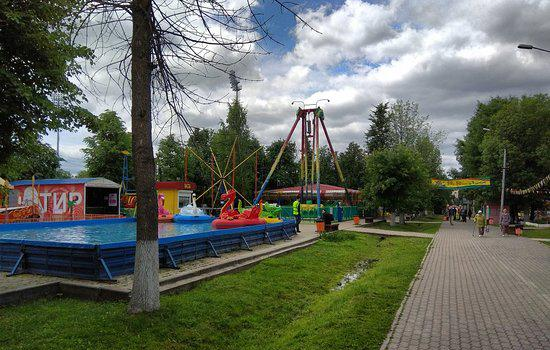
Elektrostal'

Elektrostal' Travel Guide
Experience elektrostal'.

The Moscow Kremlin

Krasnaya ploshchad'

State Historical Museum

St. Basil's Cathedral

Great Moscow State Circus

Moscow State University

Moscow Metro

Moskva River

Arbat Street
Where to stay, hotel pioner, yahonty noginsk, house in pushkino, gostinyi dvor hotel, recreation center dubki, yakhontovy les apartments, sloboda na klyazme, what to eat.

Cafe Vostochny Express

Kroshka Kartoshka

Coffee Shop Usy Teodora Glagoleva

Fabrika Obedov

Beer Club Tolsty Medved

Cafe Antresole

Quest-Cafe 4 Komnaty

Prima Bolshogo
Other recommended cities.

Popular Types of Attractions in Elektrostal'
Popular attractions in elektrostal', popular restaurants in elektrostal', popular destinations, recommended attractions at popular destinations, more things to do in elektrostal'.
- Customer Support
- Service Guarantee
- More Service Info
- Website Feedback
- About Trip.com
- Terms & Conditions
- Privacy Statement
- About Trip.com Group
Other Services
- Investor Relations
- Affiliate Program
- List My Property
- Become a Supplier

IMAGES
VIDEO
COMMENTS
Trek Bike Size Finder Apparel fit guidelines Fit & Sizing; We're here to help you with your bike sizing and cycling apparel sizing needs. Sizing charts. Use the "sizing & fit" link at the top of any product page to find the size that's best for you. Go to bikes Go to apparel
These Trek road bike size charts shall help you pick the right bicycle that can go a long way for an adventurous ride. Category - Performance/Gravel. Models/Series - Madone, Emonda, and Domane. HEIGHT. INSEAM. SIZE. 5'0″-5'2″ (152-158cm) 28″-30″ (71-75cm) 47.
You're looking at the United Kingdom / English Trek Bicycle website. Don't worry. We've all taken a wrong turn before. ... We're here to help you with your bike sizing and cycle clothing sizing needs. Sizing charts. Use the "sizing & fit" link at the top of any product page to find the size that's best for you.
This mountain bike sizing and fitting guide will. No matter which mountain bike you choose it has to match your bodies measurements as closely as possible. This mountain bike sizing and fitting guide will ... Trek Marlin 2019. 13.5 inch frame size number, wheels 27.5, standover 70.5cm 15.5 inch frame size number, wheels 27.5, standover 72.8cm ...
Our guide to mountain bike sizing will help you find the correct sized mountain bike for you, while our tips on fit will ensure your bike fits as it should.
1. Ebicycles.com Online Calculator : An easy way to find the right MTB frame size by using your height and inseam length. 2. Competitive Cyclist Fit Calculator : A more detailed bike fit calculator that lets you know the correct standover height range, top tube length, saddle height, and more. 3.
170-185 cm. 5'11"-6'1". 187-193 cm. 6'2"-6'4". 194cm+. 6'4"+. This chart is a great starting point, but isn't always the definitive answer due to varying frame geometry and riders having unique proportions. Feel free to swing by our locations to test ride a mountain bike and know for sure. Keep reading to learn about other ...
21" - 22". 53cm - 57cm. 6' 4" +. 194cm +. XXL. 23" +. 58cm +. The best place to start when trying to choose the right size mountain bike is by looking at a size chart. Our mountain bike frame size chart here is a good baseline, helping you find the right size bike for your height.
Learn how to choose the right bike size for your height, riding style and preferences. Compare road, MTB and hybrid bike sizes with our handy guide.
Mountain Bike Size Chart. Here's our mountain bike sizing chart. ... However, bear in mind that this is only an approximate mountain bike size chart, with plenty of overlaps. Depending on the bike brand or style, the key measurements described above can vary widely. For example, a mountain bike frame with an 18" seat tube from Trek could be ...
Trek Bikes Size Guide. Need to know what frame size you need for your next Trek bike? Checkout the sizing chart below: To view the latest Trek Bikes: click here. This chart use measurements suggested by Trek Bikes: Trek Remedy Size Guide Chart. Trek Slash Size Guide Chart. Trek Fuel EX Size Guide Chart. Trek Rail Size Guide Chart.
Trek bike sizing is very straightforward and varies by type. For example, mountain bikes follow a unique method called alpha sizing that uses designations such as small, medium, or large. Using this system, a 5'3" to 5'7" tall person can use a 17.5" frame size. On the other hand, Trek road bike sizing takes into account the inseam length.
Wheel size is another important factor to look for when figuring out the right bike size. Adults' mountain bikes generally have wheel diameters ranging from 26" to 29". Some manufacturers provide the same model in smaller sizes with 26" wheels and medium or larger sizes with 27.5" or 29" respectively.
You're looking at the Canada / English Trek Bicycle website. Don't worry. We've all taken a wrong turn before. ... Fit & Sizing; We're here to help you with your bike sizing and cycling apparel sizing needs. Sizing charts. Use the "sizing & fit" link at the top of any product page to find the size that's best for you. ... Mountain bikes ...
Skip to main content. Review. Trips Alerts Sign in
Elektrostal Geography. Geographic Information regarding City of Elektrostal. Elektrostal Geographical coordinates. Latitude: 55.8, Longitude: 38.45. 55° 48′ 0″ North, 38° 27′ 0″ East. Elektrostal Area. 4,951 hectares. 49.51 km² (19.12 sq mi) Elektrostal Altitude.
Most people get on their bikes to ride here in the months of June and August. Find the right bike route for you through Elektrostal, where we've got 327 cycle routes to explore. The routes you most commonly find here are of the hilly type. Most people get on their bikes to ride here in the months of June and August. ...
The Moscow Kremlin. 150***29. The armoury does not limit the time. The appointment time can be early. You can visit it yourself. Rent a Chinese interpreter for 400 rubles. You need to press your passport. There is no problem with the back passport. You can store your coat at the door, which is very good.